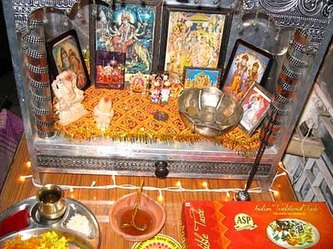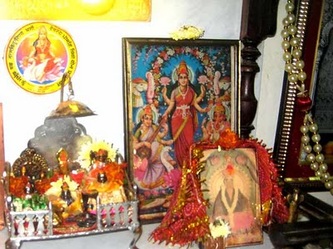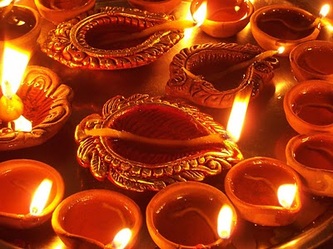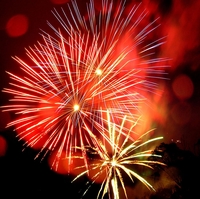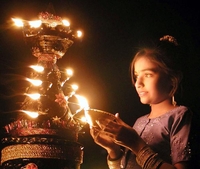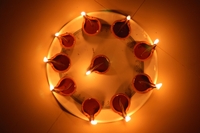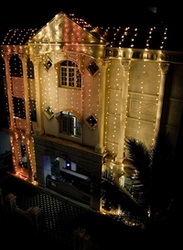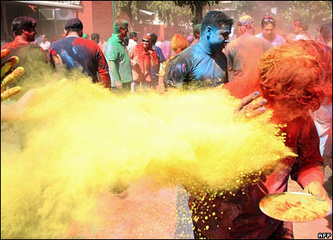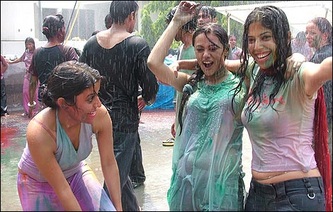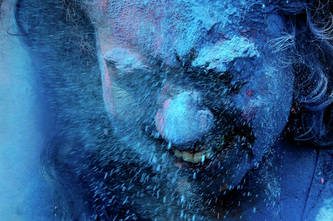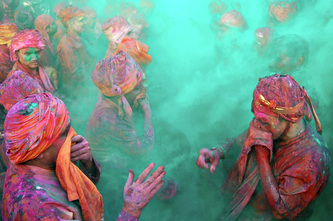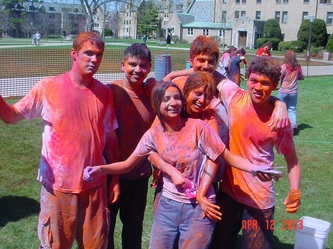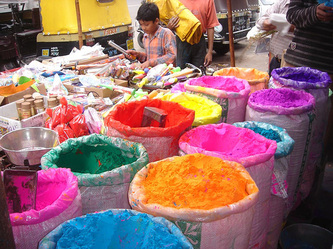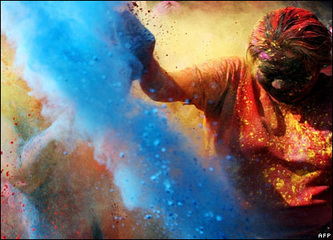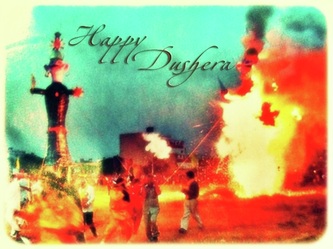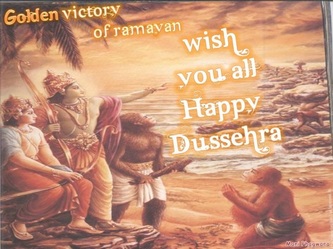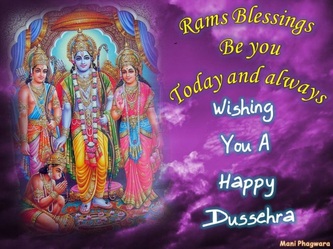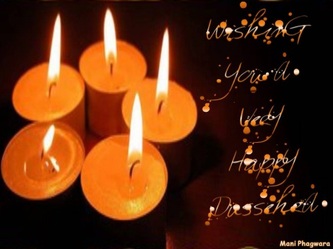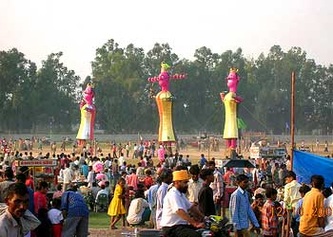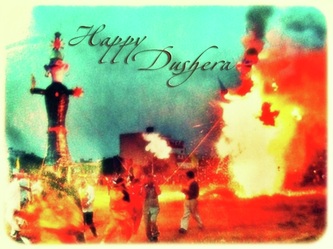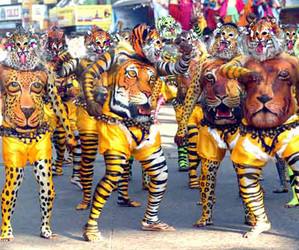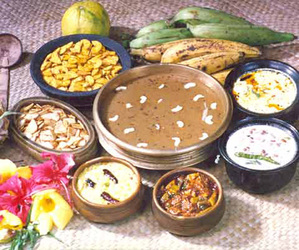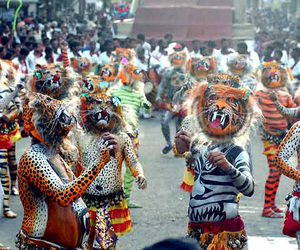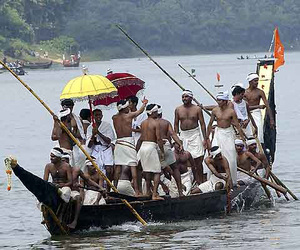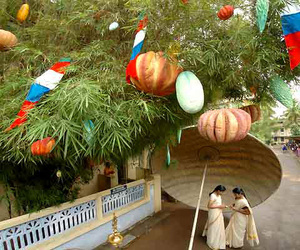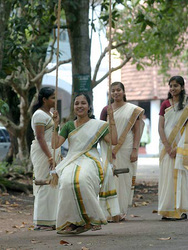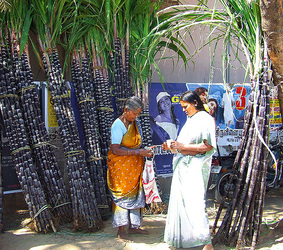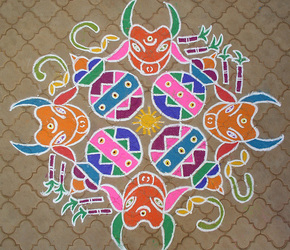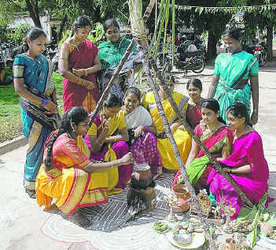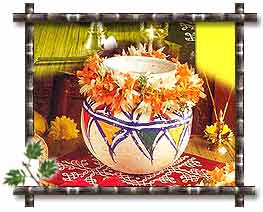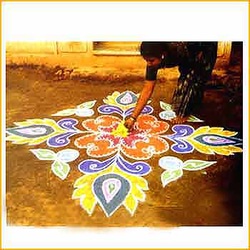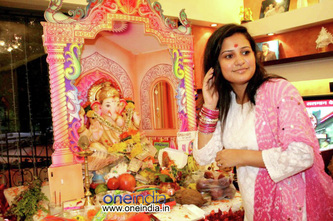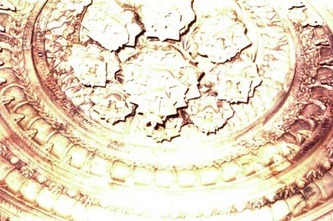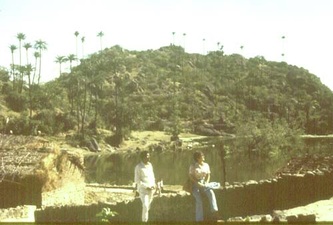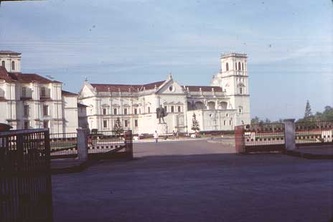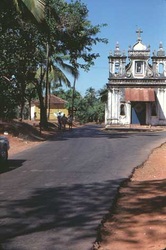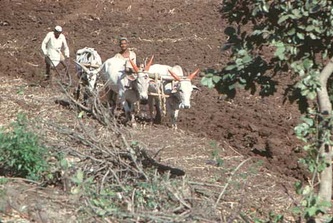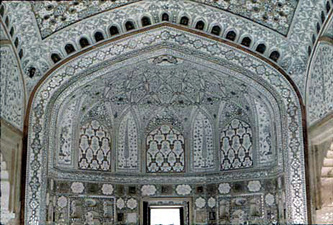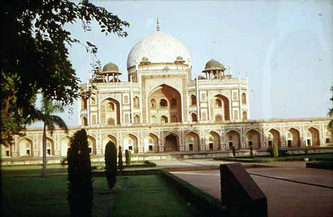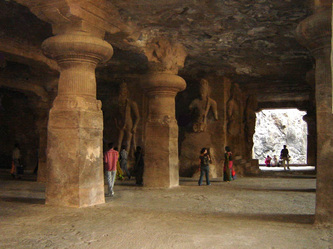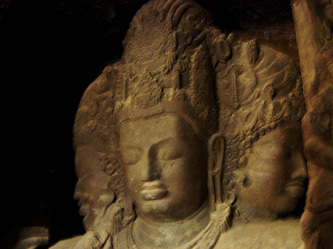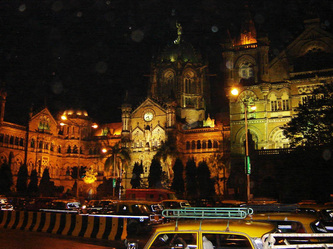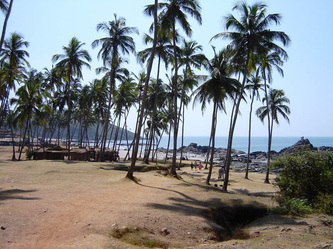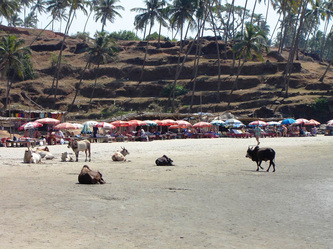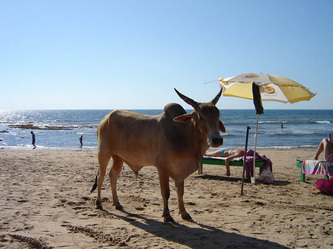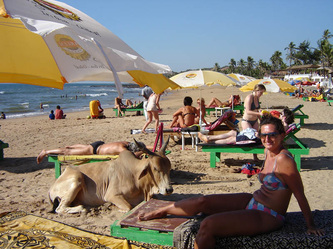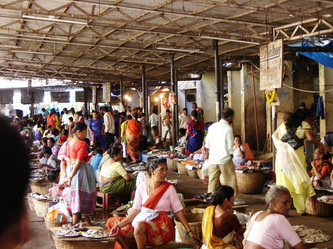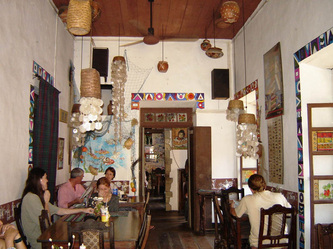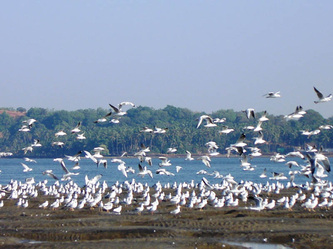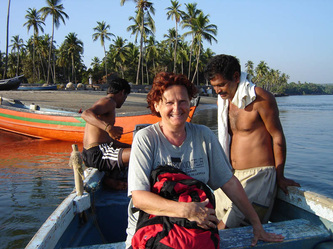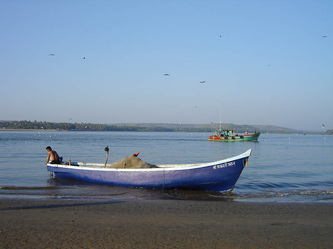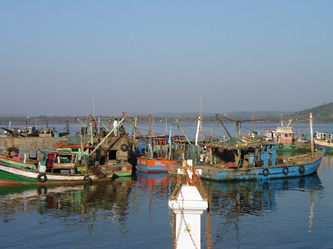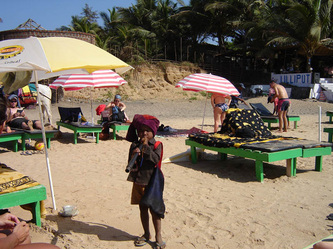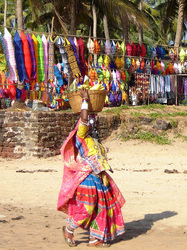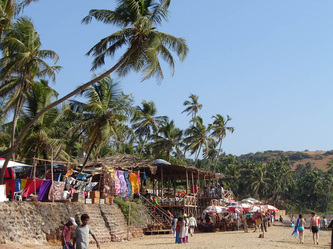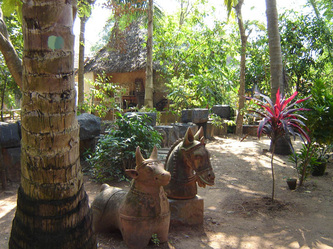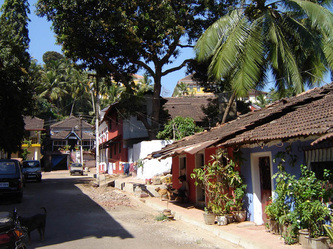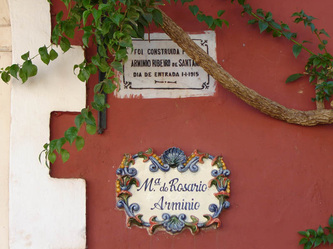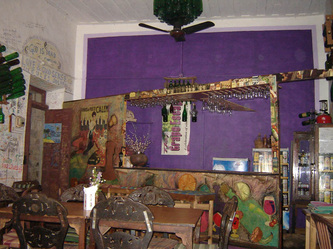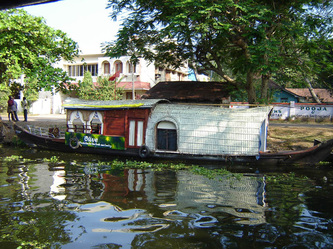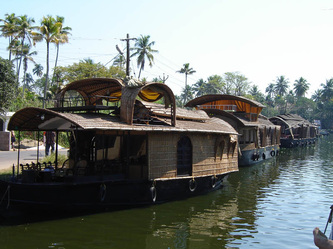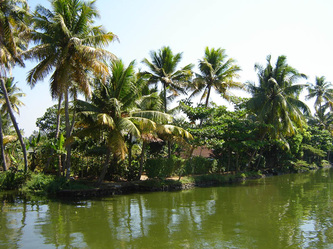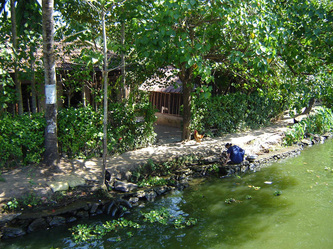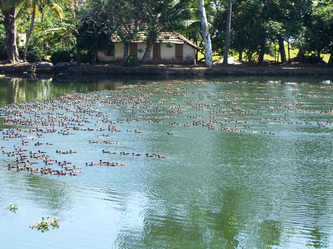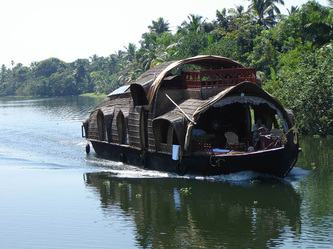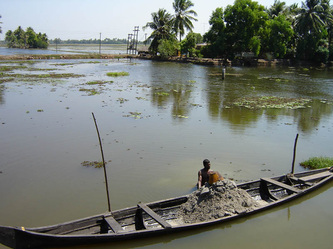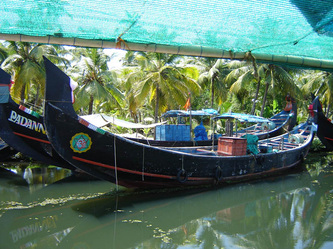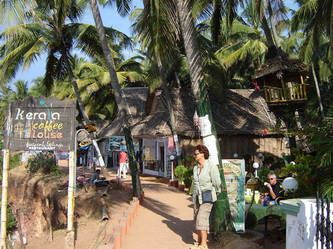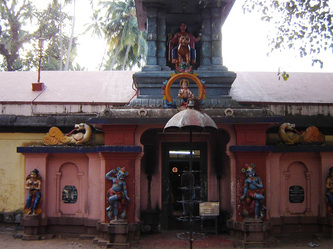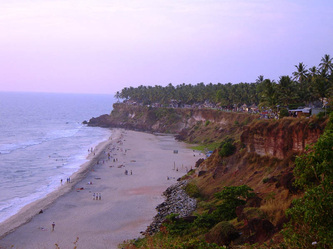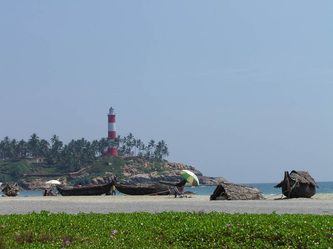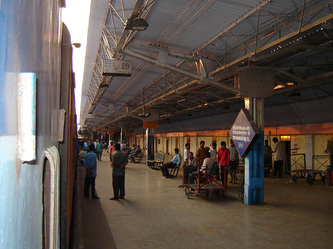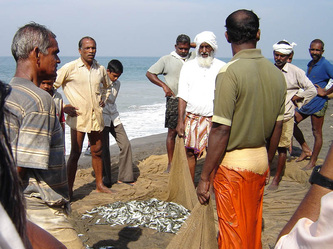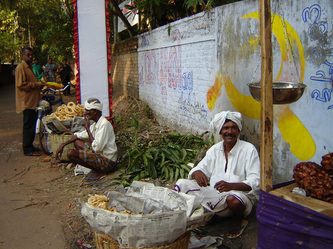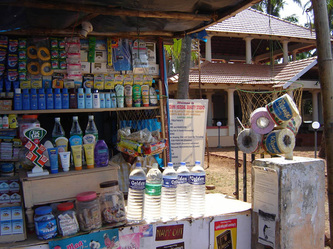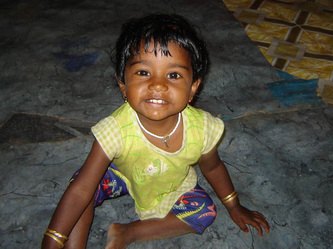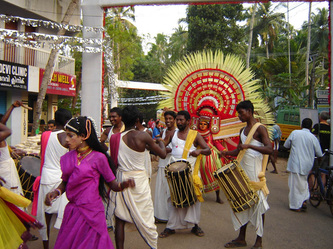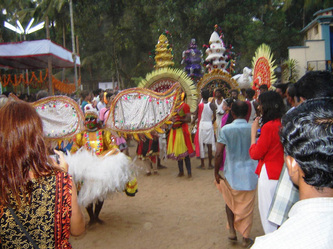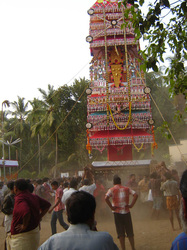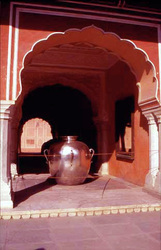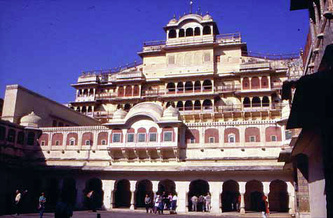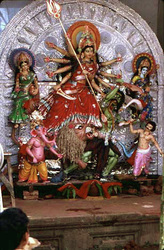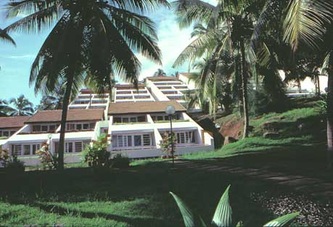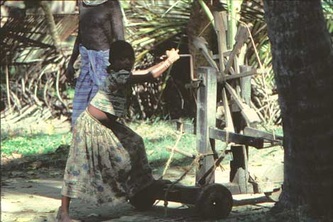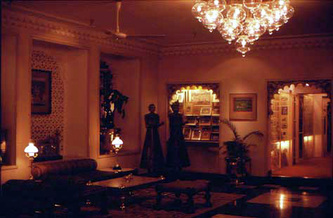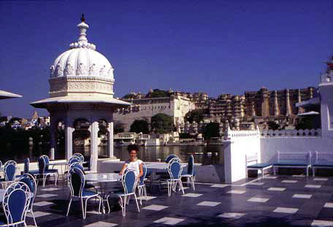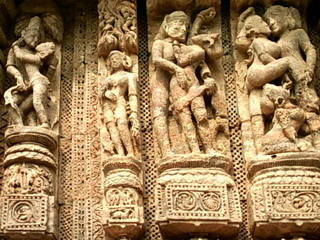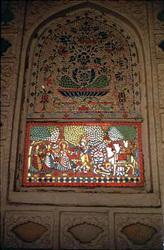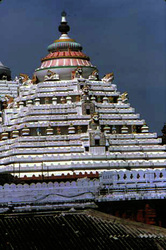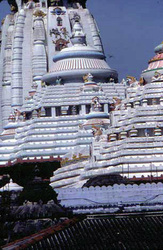GANGE
BENARES
VENARASI
În fiecare dimineaţă mii de hinduşi, dacă pelerini sau rezidenţi, îşi fac loc în apa sfântă a Gangelui.All of them face the rising sun with folded hands mumering prayers.Toate acestea se confruntă cu rasarit de soare, cu mâinile îndoite mumering rugăciuni.Eck states:Eck prevede:
"There are few things on which Hindu India, diverse as it is, might agree. But of the Ganges, India speaks with one voice. The Ganges carries an immense cultural and religious meaning for Hindus of every region and every sectarian persuasion." (214)"Sunt cateva lucruri pe care hindus India, diverse aşa cum este, s-ar putea de acord.. Dar Gange, India vorbeşte cu o singură voce persuasiune. Gange un imens cultural şi religios poartă sensul de hinduşi din fiecare regiune şi fiecare sectar" ( 214)
Cremation anywhere along the Ganges is desirable.Incinerarea oriunde de-a lungul fluviului Gange este de dorit.If that is not possible, then the relatives might later bring the ashes of the deceased to the Ganges.În cazul în care nu este posibil, atunci rudele s-ar putea aduce mai târziu cenuşa defunctei la Gange.Sometimes, if a family cannot afford firewood for cremation, a half-burned corpse is thrown into the water.Uneori, în cazul în care o familie nu îşi pot permite lemn de foc pentru incinerare, a-ars cadavru jumătate este aruncat în apă.A verse from the Mahabharata promises, "If only the bone of a person should touch the water of the Ganges, that person shall dwell, honored, in heaven."Un verset din Mahabharata promisiuni, "Dacă numai os de o persoană ar trebui să atingă apa de Gange, acea persoană va locui, onorat, în ceruri."
Pentru cei vii, scăldat în Gange este la fel de important.Hindus will travel miles and miles to have their sins washed away in these holy waters.Hinduşii va calatori mile şi mile de a avea păcatele lor spălate în aceste ape sfinte.For years Hindus have declared that there is nothing quite as cleansing as the living waters of the River of Heaven.Pentru hinduşi ani au declarat că nu este nimic destul ca curăţare ca apele de trai al râului Cerului.This "pure" water is suppoce to wash their sins away.Acest "pure" de apă este suppoce pentru a spăla păcatele lor departe.
The river Ganges draws all kinds of people and life seems to continually be bustling at its side.Râul Gange atrage tot felul de oameni şi viaţă pare să fie în permanenţă plin de viaţă, la rândul său.On the platforms and ghats are barbers cutting and trimming hair, and children flying their kites.Pe platforme şi Ghats sunt frizerie de tăiere şi tunderea părului, şi copiii lor zbor zmee.You may see young men wrestling, exercising, or in deep meditation.Puteţi vedea tineri lupte, exercitarea, sau în meditaţie profundă.Washermen are beating their clothes on stones at the edge.Washermen sunt bate hainele lor pe pietre la margine.Multi-colored saris and all sorts of wet clothes are laid out to dry in the sunshine.Multi-colorat Saris şi tot felul de haine ude sunt prevăzute să se usuce la soare.A boy may be washing his dog while a mother is taking her yelling child into the Ganges for the first time.Un baiat poate fi spălat câinele său în timp ce o mama este de a lua copilul ei strigând în Gange pentru prima dată."Banaras: India's City of Light" by Santha Rama Rau states:"Banaras: India's City of Light", de către Santha Rama Rau prevede:
"There are beggars, idlers, vendors, touts, the young, the old, the curious, the remote, the talkers, the guides, the priests, the families simply out for a stroll, the ascetics, the crippled, the woman scrubbing out household pots and pans, the toughs, the gently curious ones. All are there along the Ganges" (Rau 244)."Există cerşetori, leneşi, furnizori, touts, tineri, bătrâni, curios, de la distanţă, talkers, ghiduri, preoţi, familii pur şi simplu pentru o plimbare, asceţii, pe schilozi, pe femeia spălarea afară vase de uz casnic şi de bucătărie, toughs, curios cei uşor. Toate sunt acolo de-a lungul fluviului Gange "(Rau 244).
India este una din putinele tari al carei stil dramatic nu a fost infuentat decat vag de alte curente artistice.Cand piesele hinduse au devenit cuoscute pentru intaia oara in Europa, prin traducerea piesei SAKUNTALA in 1789 de catre Sir William Jone, s-a crezut ca literatura greaca, ce patrusese in India, a influentat stilul lor. Dar aceasta idee nu mai este valida astazi. Majoritatea criticilor afirma ca sunt de acord cu ipoteza originalitatii si lipsei de influente din dramaturgia hindusa, care este nimic mai mult decat rodul geniului local. Dramaturgul Bhasa sau Bahrta, din opera caruia s-au recuperat si publicat 13 lucrari, este considerat ca fiind fondatorul, sau mai bine zis tatal teatrului indian.Exista o confuzie considerabila in privinta adevaratilor autori ai multor piese, cunoscut fiind faptul ca se obisnuia ca cele mai bune lucrari sa fie atribuite liderului care adesea se afla in spatele adevaratului scriitor,sustinandu-l material.
Limba si replicile
Piesa, lunga de altfel, debuteaza cu un solist, care urmat de un dialog intre organizator si unul dintre actorii sai,complimenteaza si multumesc spectatorilor ca au ales sa vina sa vizoneze piesa ; apoi printr-un joc de replici piesa incepe pe nesimtite. In timpul in care se schimba decorul intre scene si acte, publicul este intretinut de o formatie muzicala. Cea mai mare parte a piesei este in proza dar cele mai tensionate scene sunt redate in versuri, fiind foarte popular catrenul. In timp ce personajele imporatante ca zeii si eroii vorbesc aceasta limba pretentiosa, a versurilor, femeile, sclavii impreuna cu alte personaje neimporatnte, vorbesc limba clasei de jos.
Manifestarile unei pasiuni interioare provenită din iubire, nu este admisa, cum nu eate permisa nici manifestarea unor sentimente ca ura, gelozia, furia sau orice altceva ce ar putea avea conotatii sexuale sau violente. Supărarea este transformata in melancolie, sărutul, dormitul, mâncatul, scarpinatul, toate sunt considerate gesturi intime si sunt interzise ca si blasfemia, calomnia, plagiatul.
Exista personaje tipice ca sclavul incapatanat, prietenul eroului. Alte procedee artistice cum sunt povestire in rama, pierderea si gasirea obiectelor, comorilor, interventia zeilor in cautarea adevarului sunt la fel de populare in India ca in oricare alt loc din lume.
De obicei clădirea teatruluiera o sala de concerte sau curtea interioara a palatului. Amenanjarea scenei era extrem de simpla, cu scaune, tronuri, si ocazional şarete trase de actori deghizati in animale. Mastile nu prea se foloseau iar costumele erau compuse din imbrăcămintea de toata ziua. Nu exista distinctie dintre tragedie si comedie pt ca ele se imbinau adesea, piesa avand mereu un final fericit
Piesele erau organizate de aristocratie pentru ocazii ca încoronari, casatorii, sarbatori, nasterea unui fiu de rege. Profesia actorului era tratata cu respect si nu se interzicea nici femeilor sa urce pe scena. O mare importanta o are un aspect foarte promovat inpiesele hinduse, acela al sacrificului suprem pentru gasirea absolutului, dramaturgia indiana urmarind sa dezvaluie filozofia socila si puternicul sentiment al credintei.
Apogeul perioadei.
Se cuosc peste 100 de piese scrise in India intre anii 400 si 900, piese care au exercitat un interes real asupra studentilor de azi. Intre acei ani au trait doi dintre cei mai mari dramaturgi ai tuturor timpurilor, Kalidasa si Bhavabuti, ale caror lucrari au fost atribuite imparatilor Sudraka si Criharsha. Doar trei drame ale fiecarui autor au supravietuit trecerii timpului.
Drame celebre.
Cea mai cunoscuta in Europa este piesa Sakuntala, piesa tradusa de Sir William Jone in 1789. Ea a generat o impresie profunda asupra scolarilor ca Goethe si a creat ceva asemanator cu un curent literar. Este in 7 acte si povestea este sustrasa din prima carte a Mahabharatei. Eroul ei, Dushyanta, afost un rege foarte areciat al antichitatii. Dialogul este mereu poetic si relevant iar actiunea este plasata intr-un spatiu situat la granita dintre real si supranatural. Datorita incarcaturii emotionale, formei versificate, puterii imaginatiei, a fost declarata de Arthur Symons cea mai stralucita piasa a tuturor timpurilor.
ORIGINILE TEATRULUI HINDUS
La inceput a fost Veda, si rasa divina popula pamantul.Rig Veda, este cea mai veche forma a teatrului hindus, si cel mai veritabil monument literar al civilizaţiei Aryane. Imnurile Rig, slaveau grandoarea naturii si a fortei ei, in special pe Indra,pe Tunator si pe Agni, zeita focului celestru si terestru. Arborigenii de culoare din Punjab nu apreciau sanscrita si ignorau cantecul Vedic dar noua rasa ce a rezultat din Dasyus a crescut si s-a dezvoltat sub influenta sancritei si a invatat aceasta limba. Cu toate acestea, nu aveau voie sa studieze Rig Veda, care rămânea un element definitoriu castelor inalte. Nimeni altcineva in afara oamenilor din clasele sociale inalte nu beneficia de regenerare spirituala.
Atharva Veda, a compus din vechea natura a cuvintelor,magie si exorcism, un nou vocabular sanscrit pentru masa populatiei. Acesta nu afost acceptat asa usor si a fost nevoie de multa perseverenta pentru introducerea ei in canoanele sacre. In timp ce Rig Veda consta in rugaciuni inchinate impresionantelor elemente naturale, Atharva este închinată elemnetelor nocive ale naturii si setei de puteri oculte.
Atharva, este cronologic vorbind mai tanara decat Sâma Veda, cartea de cantece din pasaje ale Rig, si decat Yajur Veda, care contine liturghia Vedică destinata recitarii in timpul serviciilor de sacrificare.
Dupa infaptuirea actului de creatie, a fost perioada de aur, in care oamenii si Dumnezeu traiau laolalta.Apoi, a urmat perioda de argint, cand omenirea, s-a abatut din drumul catre divinitate si fiecare si-a urmat calea. Conflictele si crimele au intunecat existenta oamenilor , dar Dumnezeu a fost indulgent si a separat cele doua sexe, pentru ca numai dragostea sa-i poata uni din nou. Inima a inceput sa ravneasca exteriorizarea sentimentelor si fiinta umana si-a pierdut puterea de introspectie. Cele 5 organe de simt au evoluat pt ca atat omul cat si zeii sa-si poata satisface setea de comunicare exterioara.
Indra, determinata de alti zei, s-a infatisat la tronul zeului-tată si a spus: <O, Brahma, dorim sa ne desfatam ochii si urechile cu cu un spectacol de drama; da porunca sa fie creata piesa de teatru pentru a ne bucura de ea.> .Atuci Creatorul a cazut pe ganduri dintre cele mai profunde si din cugetarea lui a luat nastere NÂTYA VEDA, adica Veda teatrului. Asa a fost voia Domnului care a creat a 5-a Veda, a dramaturgiei, din elementele celorlalte 4: dansul din Rig, cantecul din Sâma, gestica din Yajur, si pasiunea din Athrva. Brahma i-a propus apoi lui Vishwakarma, arhitect celestru, sa construiasca o scena in edenul Indrei.
Aceasta este legenda originii teatrului hindus. In realitate insa, el a evoluat din obiceiul ancestral de a recita versuri nationale la adunari sociale sau religioase. Triburile din regiunea Gangica, erau renumite pentru talentul recitatorilor locali. Cuvintele care desemnau denumirea acestor stramosi ai actorilor de azi erau mâgadha si bhârata. Reprezentatiile hinduse se desfasurau in locuri in care se practica venerarea zeilor, si fiindca acestea erau atat de frumoase adesea in public se aflau si reprezentati ai regalitatii, amploarea spectacolelor fiind uimitoare. In sezonul ploios, locul de desfasurare se muta la pupitrul de predici al templelor. Unul dintre actori traducea sanscrita oamenilor din castele de jos ale societatii. Totul dura cateva saptamani, noapte de noapte, fara incetare.
Dupa o vreme, sanscrita ajunsese sa fie cunoscuta de toata lumea si nu mai era nevoie de actori specializati. Tot acum au fost adaugate si formatiile muzicale la spectacole pentru a da o savooare mai puternica actului.
Cele mai vechi drame indiene nu au fost compuse in sanscrita ci in prâkrita. Mahâ-Bhârata si Râmâyana oferau surse inepuizabile de inspiratie, cum in Europa oferă si azi, Biblia. Chiar si asa, la inceput, Prâkrit Sanvâda, adica drama prâkrită, reprezenta o concentrare de mari mistere caci se credea ca fie Krishna, sau Shiva dansau in mare parte pe scena. O mare de oameni venea sa asiste la aceste spectacole in aer liber. Preotimea Veda, a intentionat sa sustraga din piese tot ceea ce contrasta cu credinta lor populara in cei doi zei primordiali, dar sândavele, datorită veseliei lor galagioase si a aprecierii de care aveau parte, au supravietuit si au fost jucate chiar si in sanscrita, mai tarziu. Cu toate ca reduceau zeii la simple personaje de scena, sândavele s-au bucurat de o popularitate imensa in randul oamenilor proveniti din toate castele. Subiecte precum relatiile dintre Krishna si Arjun sau misticele colocvii tinute de Shiva si Kâli in legatura cu Tantras nu sunt decat dezvoltari mai tarzii ale vechiului teatru prâkrit, care nici chiar in perioda Rig Veda nu erau intelese in totalitate.
Doi dintre cei mai cunoscuti dramaturgi prâkriti sunt Saumilla si Bhâsa.
Bharata a conceput un tratat despre arta dramatica. Acest eseu, abunda in cuvinte prâkrite, majoritatea desemnand indicatii de regie, enumerand o multime de termeni si dialecte pârakrite care pot sluji, in concordanta cu traditiile stravechi, la punerea in scena a unei piese. Toatea acestea se refereau la limbajul personajelor care trebuia sa fie cat mai colorat si mai diversificat, dialectic vorbind, pentru ca ceea ce e pe scena sa fie in armonie cu realitatea sociala a acelor timpuri. Astfel s-au creat unele tipologii dupa care se ghidau dramaturgii si pe care le respectau, precum limbajul sclavilor care trebuia sa fie vulgar fara a incalca normele bunei-cuviinte, limbajul aristocratilor care trebuia sa fie ales, fara a fi prea dificil de inteles si asa mai departe.
Bharta, care a devenit zeul tultelar al teatrului hindus, nu mai este pentru multi o persoana atestata istoric capatand amploarea unui simbol, ca Vyâsa sau Manu. Numele lui poate avea legatura directa cu pretioasele carti Bhârta Sutra, care s-au pierdut in valtoarea timpului. Datorita acestor carti, a indicatiilor scenice ce stau sub semnatura lui si a actorilor, care se numesc bhârta, adevaratul Bhârta isi are existentă imaginara. Bharta Sutra a fost considerata sacra pentru valoarea si vechimea ei, de catre Kâlidâsha si alti mari dramaturgi. De ce sa ne mai miram atunci ca s-a dezvoltat mitul conform caruia Bharta ar fi copiat aceste carti din a cincea Veda, care se credea a fi o creatie a lui Brahma insusi?
Diwali
Diwali is regarded as one of the most important festival of the Hindu calendar. Diwali este considerată ca fiind una dintre cele mai important festival din calendarul hindus. It is celebrated across the nation with great pomp and excitement. Este sărbătorită în întreaga naţiune cu mare pompă şi emoţie. The festival is mainly associated with lights as it is called the festival of light. Festivalul este asociat în principal cu lumini cum este numit festival de lumină. On the day of the festival diyas (small clay lamps) are lit in everybody's home irrespective of their social status. În ziua de diyas festivalului (argilă lămpi mici) sunt aprinse în toată lumea de origine, indiferent de statutul lor social. The name Diwali signifies 'rows of lighted lamps'. The înseamnă Numele Diwali "rânduri de lămpi aprinse". Diwali is a five-day festival, beginning on the 15th day of the Hindu calendar month of Kartika (Ashwin). Diwali este o zi de festival-cinci, începând de la data de 15 a lunii calendaristice hinduse de Kartika (Ashwin). By the Gregorian calendar, Diwali falls in October or November. De calendarul gregorian, Diwali cade în luna octombrie sau noiembrie. Diwali marks the beginning of the Hindu and Gujarati New Year and is celebrated with the lighting of lamps and candles, and lots of fireworks. Diwali marchează începutul hinduse şi de Anul Nou gujarati şi este celebrată cu iluminat de lămpi şi lumânări, şi o mulţime de focuri de artificii. People decorate their home with beautiful diyas and making rangoli pattern in the courtyard and in front of the gate. Oamenii decora casa lor cu diyas frumoase şi de a face modelul Rangoli în curte şi în faţa porţii. They put flowers and mango leaves on their doors and windows. Ei au pus flori şi frunze de mango pe uşi şi ferestre. Diyas and candles are placed on rooftops, rooms, and kitchen and even in the bathrooms. Diyas şi lumânări sunt plasate pe acoperişuri, camere, bucătărie şi chiar şi în băi. On this day, people worship Lord Ganesha, the foremost of all Hindu Gods and Goddess Lakshmi, the Goddess of Wealth and Prosperity. În această zi, oamenii se închine Domnului Ganesha, cel mai important al tuturor zeilor hindusi şi Lakshmi, zeiţa de bogăţie şi prosperitate. It is time to exchange gifts and sweets with friends, relatives and neighbors. Este timpul sa schimb de cadouri şi dulciuri, cu prieteni, rude şi vecini.
Due to India's varied cultural diversity there are many manifestations of the Diwali festival. Datorită India diversităţii culturale variate, există multe manifestări ale festivalului Diwali. The festival begins with Dhanteras, a day set aside to worship the goddess of prosperity, Goddess Lakshmi. Festivalul a începe cu Dhanteras, o zi retrase din circuitul agricol să se închine zeita de prosperitate, zeita Lakshmi. On this day, homes are cleaned and paintings are done. În această zi, casele sunt curăţate şi picturi sunt realizate. There are various legends associated with the celebration of Diwali. Există diferite legende asociate cu celebrarea de Diwali. But people mostly associate the celebration with the legend of Lord Ram returning to his kingdom of Ayodhya after fourteen years of exile and defeating Ravana, the demon king. Dar oamenii asociază mai ales cu celebrarea legenda a Domnului Ram întorc în regatul său de Ayodhya după paisprezece ani de exil şi învinge Ravana, regele demon. In Bengal, the celebration is marked with the worship of Goddess Kali. În Bengal, celebrarea este marcat cu cultul zeiţei Kali. People celebrate Kali puja with great fervor and enthusiasm. Oamenii sărbători puja Kali cu fervoare şi entuziasm. Joy and festivity reins every corner of the nation during the Diwali season. Diwali festival is the one Hindu festival that unites the whole of India. Bucurie şi frâu festivitate fiecare colţ al naţiunii în timpul sezonului de Diwali. Festivalului Diwali este un festival hindus care uneşte întreaga India. The exchange of sweets and the explosion of fireworks customarily accompany the celebration of the festival. Schimbul de dulciuri şi a exploziei de focuri de artificii însoţească obişnuit celebrarea a festivalului. Diwali is an occasion for cheerfulness and togetherness. Diwali este o ocazie de bucurie şi comuniune. This is that time of the year when people of all age and all class take part in its celebration. Aceasta este acel moment din an când oamenii de toate vârstele şi de toate de clasă să ia parte la celebrare a acesteia.
Deepawali Festivităţi
The festival of Diwali reminds us of the festive season of joy, splendor, enthusiasm and happiness. Festivalul de Diwali ne aminteşte de sezon festiv de bucurie, splendoarea, entuziasm şi fericire. It is the festival of lights and is celebrated with great excitement by all Indians all over the world. Este festival al luminilor şi este sărbătorită cu mare entuziasm de către toţi indienii din întreaga lume. The uniqueness of the festival is that it is celebrated for five days and each of the days has a special significance and importance. Unicitatea a festivalului este faptul că este sărbătorită pentru cinci zile şi fiecare dintre zilele are o semnificaţie deosebită şi importanţă. Each of the five days is based of five varied philosophies, with each day to a special thought or ideal. Fiecare dintre cele cinci zile se bazează de cinci filosofii variat, cu fiecare zi la un gând special sau ideal. The first day of Diwali is called the Dhanteras, Dhanwantari Triodasi or Dhantryaodashi, which falls on the thirteenth day of the month of Ashwin. Prima zi a Diwali este numit Dhanteras, Dhanwantari Triodasi sau Dhantryaodashi, care se încadrează în a treisprezecea zi a lunii de Ashwin. On this day, Lord Dhanwantari came out of the ocean with Ayurveda for mankind. În această zi, Domnul a Dhanwantari a ieşit din ocean cu Ayurveda pentru omenire. This day marks the beginning of Diwali celebrations. Această zi marchează începutul a sărbători Diwali. On this day at sunset offerings are made of sweets during worship time to Lord Yama (the Lord of Death) for the protection from untimely death. În această zi, la apus de soare sunt ofertele făcute de dulciuri în timpul cult la Domnul Yama (Lord of Death) pentru protecţie de la moartea prematură. It is mainly done near a Tulsi tree (basil tree) or any other sacred tree. Se face în principal aproape de un copac Tulsi (copac busuioc) sau orice alt copac sacru.
The second day is called the Narak Chaturdasi. A doua zi este numit Chaturdasi Narak. It is the Choti Diwali celebration. Este Choti celebrare Diwali. On this day Lord Krishna killed the demon Narakasur and made the world free from evil power. În această zi Domnul Krishna ucis demonul Narakasur şi a făcut lumea liberă de la putere rău. It falls on the fourteenth lunar day of the dark fortnight of the month of Kartik and the eve of Diwali. The third and the most important day of Diwali is marked with Lakshmi Puja. Acesta cade în ziua a paisprezecea a Lunii două săptămâni întunecată a lunii Kartik şi în ajunul de Diwali. Treia şi cea mai importantă zi a Diwali este marcat cu Lakshmi Puja. It is the main day of celebration. Este ziua principal de sărbătoare. On this day Goddess Laxmi is worshipped. În această zi Zeita Laxmi este venerat. All the Hindu family clean their house and themselves and join with their families and relative the puja of divine Goddess Lakshmi to achieve the blessings of wealth and prosperity, the triumph of good over evil and light over darkness. Toate familie hindus curat casa lor şi de ei înşişi şi să se alăture cu familiile lor şi relativă puja de divin Zeitei Lakshmi pentru a atinge binecuvântările de bogăţie şi prosperitate, triumful binelui asupra răului şi a luminii asupra întunericului. Diwali marks the last day of financial year in traditional Hindu business and businessmen perform Chopda Pujan on this day on the new books of accounts. Diwali marcheaza ultima zi a exerciţiului financiar în hinduse tradiţionale de afaceri şi oameni de afaceri a efectua Chopda Pujan în această zi pe noile cărţi de conturi. Any new business or venture starts with Diwali puja. noi sau de afaceri de risc Orice începe cu Puja Diwali. The fourth day of Diwali is called Padwa or VarshaPratipada and Govardhan Puja, that marks the coronation of King Vikramaditya and Vikaram-Samvat was started from this Padwa day. On this day, Govardhan Pooja is performed. A patra zi de Diwali este numit Padwa sau VarshaPratipada şi Govardhan Puja, care marchează încoronarea regelui Vikramaditya şi Vikaram-Samvat a fost pornit de la această zi Padwa. În această zi, Govardhan Pooja este realizată. Many thousands of years ago, Lord Krishna caused the people of Vraja to perform Govardhan Pooja. Mai multe mii de ani în urmă, Domnul Krishna a provocat oamenii de Vraja pentru a efectua Govardhan Pooja. From that time onwards every year Hindus worship Govardhan. Din acel moment începând în fiecare an Govardhan cult hinduşi. This day is also observed as Annakoot and prayers are offered in the temples. Această zi este, de asemenea observat ca Annakoot şi rugăciuni sunt oferite în temple. The fifth day of Diwali is celebrated as Bhai Duj or Bhratri Dooj. A cincea zi de Diwali este sărbătorită ca Bhai DUJ sau Dooj Bhratri. This is the day after Goverdhan Pooja is performed and normally two days after Diwali. It is a day dedicated to brothers and sisters. Aceasta este a doua zi după Goverdhan Pooja este efectuat şi în mod normal, la două zile după Diwali este. Este o zi dedicata fraţi şi surori. The rituals are more or less like Raksha Bandhan where the sisters pray for the well being of their brothers. Ritualurile sunt mai mult sau mai puţin ca Raksha Bandhan unde surorile se roage pentru bunăstarea fraţii lor. The celebration of Bhai Dooj marks the end of the five days of Diwali celebrations. Celebrarea Bhai Dooj marchează sfârşitul celor cinci zile de sărbători Diwali. This is also known as Bhai fota among Bengalis. Acest lucru este, de asemenea, cunoscut sub numele de Fota Bhai printre bengalezi. Bhai fota is an event especially among Bengalis when the sister prays for her brother's safety, success and well-being. Fota Bhai este un eveniment special în rândul bengalezi atunci când se roagă sora pentru fratele ei de siguranţă, succesul şi bunăstarea.
Dhanteras
Dhanteras is an important part of Diwali celebrations. Dhanteras este o parte importantă a sărbători Diwali. Dhanteras marks the first day of Diwali celebrations. Dhanteras is also called Dhanvantari Trayodashi. Dhanteras marchează prima zi a sărbători Diwali. Dhanteras este numit, de asemenea, Dhanvantari Trayodashi. It falls on the thirteenth lunar day of Krishna Paksha in the Hindu month of Kartik (October-November). Acesta cade în ziua a treisprezecea lunar Krishna Paksha în luna hinduse din Kartik (octombrie-noiembrie). The word 'Dhan' signifies money or wealth. "Dhan" Cuvântul înseamnă bani sau avere. On the day of Dhanteras, people worship the Goddess of Wealth (Goddess Lakshmi). În ziua de Dhanteras, oameni cult Zeita de avere (Zeiţa Lakshmi). Since Dhanteras is associated with the worship of Goddess Lakshmi, it is a very important celebration in the homes of the mercantile community. Deoarece Dhanteras este asociat cu cultul zeiţei Lakshmi, este o sărbătoare foarte importantă în casele a comunităţii mercantil. In India, houses and market places wear a festive look on the day of Dhanteras and market places are abuzz with people all around. În India, case şi locuri de piaţă purta un aspect festiv în ziua de Dhanteras şi a locurilor de piaţă sunt abuzz cu oameni peste tot în jurul.
Legends of Dhanteras Legends de Dhanteras
Like most of the Indian festivals, Dhanteras too has some legends associated with its celebration. Ca de cele mai multe festivaluri indiene, Dhanteras are prea unele legende asociate cu celebrare a acesteia. Let's have a look at some of the popular legends that are associated with this Dhantears celebration. Să aruncăm o privire la unele din legendele populare care sunt asociate cu această sărbătoare Dhantears.
Legend of Dhanwantari Legenda de Dhanwantari
Churning of ocean (Samudramanthan) by Gods and demons forms an important part of the Hindu mythology. Baterea ocean (Samudramanthan), de zei şi demoni reprezintă o parte importantă a mitologiei hinduse. It is believed that during the churning of ocean by Gods and demons, Lord Dhanvantari (the Physician of Gods) emerged out with a jar of Amrit (elixir) on the day of Dhanteras. Thus, the worship of Lord Dhanvantari has become a part of Dhanteras celebrations in most of the home. Se crede că, în timpul baterea ocean de zei şi demoni, Domnul Dhanvantari (medic al zeilor) a apărut cu un borcan de Amrit (elixir) în ziua de Dhanteras. Astfel, închinarea Domnului Dhanvantari a devenit o parte a Dhanteras festivităţile în cea mai mare parte de origine.
Legend of Yamadeep Daan Ritual Legenda de Ritual Daan Yamadeep
According to this legend, the sixteen-year-old son of King Hima was doomed to die of snakebite on the fourth day of his marriage. Conform acestei legendei, de ani, fiul regelui şaisprezece Hima a fost sortit să moară de Snakebite în a patra zi a căsătoriei sale. Aware of the forecast about her husband, the intelligent wife of the young prince made a plan to save her husband. Conştient de previziunile despre soţul ei, soţia inteligent de tânărul prinţ a făcut un plan pentru a salva soţul ei. On the predicted day, the wife made all arrangements so that her husband did not fall asleep. În ziua a prezis, soţia făcut toate aranjamentele pentru ca sotul ei nu a adormi. Bedsides this, she also put all her silver and gold ornaments at the entrance of the door and illuminated the whole place with lamps and lights. Noptiere aceasta, ea a pus, de asemenea, tot ei argint şi podoabe de aur de la intrare a uşii şi iluminate tot locul cu lămpi şi lumini. To insure that the husband did not sleep, the wife sang and narrated stories all through the night. Pentru a se asigura că soţul nu a dormit, soţia cântat şi narat povesti toate prin noapte.
Lord Yama, the mythological God of Death, arrived in the guise of a serpent but the illumination caused by lights dazzled his eyes and he was not able to enter the room of the young prince. Domnul Yama, Dumnezeul mitologice de Death, a ajuns în masca de un şarpe, dar iluminarea cauzate de lumini uimit ochii lui, şi el nu a putut să intre în sala de tânărul prinţ. The legends have it that the serpent, mesmerized by the melodious songs of the Princess's wife, sat on the heap of ornaments and spent the night and went away in the morning. Legendele avea că şarpele, fascinat de cântece melodios al lui Princess soţia, se aşeză pe movila de ornamente şi a petrecut noaptea şi a plecat în dimineaţa. Thus, the Prince was saved by the illumination of the lamps and devotion of his wife. Astfel, prinţul a fost salvat de iluminare a lămpilor şi devotamentul de soţia sa. This legend led to the popularization of the tradition of 'Yamadeep Daan'. Aceasta legenda a dus la popularizarea tradiţia "Yamadeep Daan". It is due to this reason, lamps and diyas are kept burning all through the night on Dhanteras. Aceasta se datorează acest motiv, lămpi şi diyas sunt păstrate de ardere prin toate noaptea pe Dhanteras.
Rituals and Celebrations of Dhanteras Ritualuri şi Festivităţi de Dhanteras
As Dhanteras is associated with the worship of Goddess Lakshmi, people draw small footprints with rice flour and vermilion powder throughout the house right from the entrance (indicating the arrival of Goddess Lakshmi). Ca Dhanteras este asociat cu cultul zeiţei Lakshmi, oameni trage urme mici, cu făină de orez şi praf purpuriu tot dreptul de casa de la intrare (care indică sosirea a zeitei Lakshmi). As Dhantrayodashi or Dhanteras is considered very auspicious, people shop for gold, silver and some utensils. Ca Dhantrayodashi sau Dhanteras este considerat foarte bun augur, magazin de oameni pentru aur, argint şi unele ustensile. To celebrate the auspicious arrival of Goddess Lakshmi, the homes of people are illuminated by oil lamps, which are lit throughout the night. Pentru a sărbători sosirea de bun augur a zeitei Lakshmi, casele de oameni sunt iluminate de lămpi cu petrol, care sunt aprinse toată noaptea. Lakshmi Puja is also an important part of the Dhanteras celebrations. Lakshmi Puja este, de asemenea, o parte importantă a sărbători Dhanteras. The Lakshmi-Puja is performed at midnight. Lakshmi-Puja se realizează la miezul nopţii. Devotional songs, in praise of Goddess Lakshmi, are sung by the people. melodii Devotional, în lauda de Zeitei Lakshmi, sunt cântate de oameni. Goddess Lakshi is offered naivedya of sweets, which serve as the auspicious Prasad of the Goddess. In many parts of South India, there is a tradition of cow worship by the farmers (on Dhanteras). Zeita Lakshi este oferit naivedya de dulciuri, care servesc ca Prasad de bun augur al Zeitei,. În multe părţi din India de Sud există o tradiţie de cult vacă de fermieri (pe Dhanteras). For farmers, cows signify wealth and are considered to be the incarnation of Goddess Lakshmi. Pentru fermieri, vaci semnifica bogăţia şi sunt considerate a fi întruparea Zeiţa Lakshmi.
Diwali Cadouri
Thinking of Diwali we think of Diwali gifts, sweets and firecrackers. Gândire de Diwali ne gândim la Diwali cadouri, dulciuri şi petarde. It is the most famous and important festival in the Hindu calendar. Este celebru şi cel mai important festival din calendarul hindus. All Indians not only in our country but abroad celebrate it with great enthusiasm and joy too. Toate indieni nu numai în ţara noastră dar şi din străinătate se sărbătorească cu mare entuziasm şi bucurie prea. It is regarded as the festival of lights. Este considerată ca festival al luminilor. The festival is celebrated in different manner through out the nation. Festivalul este celebrată în mod diferit prin faptul naţiunii. But the universal theme behind its celebration is intact across the country. Dar tema universal din spatele celebrare a acesteia este intact în întreaga ţară. The uniqueness of Diwali festival is its harmony of five varied philosophies, with each day to a special thought or idea and belief. Unicitatea festivalului Diwali este armonia sa de cinci filosofii variat, cu fiecare zi la un gând special sau o idee şi credinţă. It is the time to socialize met friends and relatives. Este timpul pentru a socializa prieteni îndeplinite şi rude. If somebody is staying abroad away from home than they come to met during this festive season exchange gifts and share home-cooked meals. Dacă cineva are drept de şedere în străinătate departe de casa decat au venit la întâlnit în timpul acestui sezon cadouri schimb festiv şi a cotei de acasă-gătite mese. The festivities surrounding Diwali encourage people to gather and socialize. Diwali is the time to exchange gifts and enjoy. Festivitati din jurul Diwali încuraja oamenii să adune şi socializa. Diwali este timpul să schimb de cadouri şi să se bucure. It's the time to gift your loved one gift that they will enjoy. Este timpul să darul dragi un cadou pe care ei se vor bucura. Diwali gifts spread joy, splendor, brightness and happiness. Cadouri Diwali bucurie răspândit, splendoare, strălucire şi fericire.
Diwali is known throughout the world for it's celebratory fervor. Jewellery, new clothes, fresh flowers and offerings of traditional sweets sum up a typical Indian celebration. Diwali este cunoscut în întreaga lume, pentru că este fervoarea festive. Bijuterii, haine noi, flori proaspete şi ofertele de dulciuri tradiţionale suma o sărbătoare tipic indian. Diwali is one such occasion where this particular description would fit perfectly. Diwali este o astfel de ocazie în cazul în care această descriere special, s-ar potrivi perfect. One of the most colorful and vibrant of the Indian festivals, people visits the places of their relatives and friends to wish them on the occasion of Diwali and exchange gifts. Una dintre cele mai colorate şi vibrante de indian, cele mai multe festivaluri de oameni vizitează locurile de rudele şi prietenii lor, să le urez cu ocazia Diwali şi cadouri de schimb. Gifts can be in any form depending on the budget and to whom you are gifting. Cadouri pot fi în orice formă, în funcţie de buget şi cărora le-aţi sunt Gifting. Before selecting the gift you should know whom you are giving and what are its likes and dislikes. Înainte de a selecta cadou ar trebui să ştii cine eşti şi care sunt oferindu-i place şi displace. If you are giving anything to your brother it can be from clothes to perfumes to electronic goods to accessories like watches. Dacă vă dau nimic pentru fratele tău poate fi de la haine la parfumuri pentru bunuri electronice pentru accesorii cum ar fi ceasuri. For sisters it can be sarees , dress materials, perfumes , jewellery or anything of her choice. Pentru surori poate fi sarees , materiale rochie, parfumuri , bijuterii sau orice altceva de alegerea ei. Flowers, chocolates and traditional sweets are an all time favorite. Flori, ciocolată şi dulciuri tradiţionale sunt un timp favorit toate. You can choose from a varied range available in the market or you can make sweets at home. Neighbors and friends drop in and it is customary to exchange gifts. Puteţi alege dintr-o gamă variată disponibile în piaţă sau puteţi face dulciuri la domiciliu şi vecinii şi prietenii. Picătură în se obişnuieşte să se schimb de daruri. For the business associates it could be something in silver or gold coin or leather goods, for the daughter-in-law a sari or a piece of jewellery, for the son may be a watch, a camera or even electronic goods can be a good option. Pentru partenerii de afaceri ar putea fi ceva sau în aur sau monede de argint din piele, pentru fiica-in-lege a sari sau o bucată de bijuterii, pentru fiul poate fi un ceas, un aparat de fotografiat sau chiar produse electronice poate fi un bun opţiune. Exchange of gifts in Diwali is now a custom. Schimb de cadouri în Diwali este acum un obicei. It is not necessary that you have to gift expensive items but it is important to show your concern and feelings for the other person. Nu este necesar că trebuie să articole pentru cadouri scumpe, dar este important pentru a arăta îngrijorarea si sentimentele tale pentru alte persoane. Since Diwali signifies fun, love and enjoyment. Deoarece Diwali semnifică distracţie, dragoste si bucurie.
Când este Diwali
Whenever we talk of Diwali festival the first think that comes to our mind is when Diwali is celebrated or the date of the festival. Ori de câte ori vorbim despre festivalului Diwali a gândi mai întâi că vine mintea noastră este atunci când Diwali este sărbătorită sau de la data festivalului. Normally according to the Hindu calendar the festival of Diwali, which is celebration of truth and light is celebrated on a nation-wide scale on Amavasya, the 15th day of the dark fortnight of the Hindu month of Ashwin (Aasho), which is usually the month of October or November every year. În mod normal, conform calendarului de festival hindus de Diwali, care este celebrarea de adevăr şi lumină este sărbătorită pe o scară largă-naţiune de pe Amavasya, la data de 15 a închis două săptămâni a lunii hinduse de Ashwin (Aasho), care este de obicei luna octombrie sau noiembrie în fiecare an. Here are list of dates for the coming Five years of Diwali Festival. Iată lista de date pentru următorii cinci ani de Diwali Festival. They are as follows: Ele sunt după cum urmează:
- In 2010 , Diwali will be celebrated on 5th Nov În 2010, Diwali va fi sărbătorită pe 05 noiembrie 2010
- In 2011 , Diwali va fi sărbătorită pe 26 octombrie 2011
- I În 2012, Diwali va fi sărbătorită pe treisprezecea noiembrie 2012
· Diwali Reţete
· The festival of Diwali gives us the license for fun and revelry. Festivalul de Diwali ne dă licenţă pentru distracţie şi orgie. During the festive season of Diwali, India dresses up in a new look of fun and feasts. În timpul sezonului festiv de Diwali, rochii de India într-un nou look de distracţie şi de sărbători. Diwali is the time for decorating your house with earthen lamps called diya, wearing new clothes, bursting firecrackers, meeting family and friends and of course enjoying the delicious items of sweets and snacks prepared specially for this occasion. Diwali este timpul pentru decorarea casei tale cu lămpi de lut numit Diya, purtând haine noi, de rupere petarde, reuniuni de familie şi prieteni şi, desigur, bucurându-se de elemente de delicioase dulciuri şi gustări pregătite special pentru această ocazie. People make colorful rangoli patterns in front of their house to give a festive look, special Diwali recipes are made and even gift items and greeting cards. Oamenii fac Rangoli modele colorate în faţa casei lor de a da un aspect festiv, Diwali reţete speciale sunt făcute chiar şi articole pentru cadouri si felicitari. Weeks before Diwali, every Hindu family is busy painting and decorating their homes, and shopping for gifts and preparing new dishes. Săptămâni înainte de Diwali, fiecare familie hindus este ocupat pictură şi decorare casele lor, şi cumpărături pentru cadouri şi pregătirea feluri de mâncare noi. On the Diwali day, shops are packed with people buying freshly made sweets. În ziua Diwali, magazinele sunt pline cu oameni de cumpărare a făcut dulciuri proaspăt. You can choose from a wide variety of sweets available in the market ranging from dry fruit sweets to special Diwali sweets. Puteţi alege dintr-o mare varietate de dulciuri disponibile pe piaţă, variind de la fructe uscate dulciuri la Diwali dulciuri speciale.
Here are some recipes for sweets, which you can try at home as they are easy to make and fast to cook. Iată câteva reţete pentru dulciuri, pe care le puteţi încerca acasă în care acestea sunt uşor de a face rapid şi pentru a găti. You can try out these dishes and serve to your guests on the festive day. Puteţi încerca aceste feluri de mâncare şi servesc la vizitatori pe zi festivă.
Holi - the festival of colors is one of the most popular festivals of the country. Holi - festival de culori este una din cele mai populare festivaluri din ţară. It is celebrated during the Spring season and embodies all the festivity, liveliness and exuberance of the season. Acesta este celebrat în timpul sezonului de primăvară şi întruchipează toate festivitate, animaţia şi exuberanţa de sezon. Holi is the festival of young hearts. Holi este festivalul de inimi tinere. Spraying colors, dancing on traditional Holi songs, rhythmic drum beats and wild processions are the common scenes that one comes across during this festival. Pulverizarea culori, dansând pe Holi cântece tradiţionale, ritmic tobelor şi procesiuni sălbatice sunt scene comune care vine peste timpul acestui festival. The festival is associated with various legends but the most popular among them is the tale of Hollika. Festivalul este asociat cu diferite legende, dar cele mai populare printre ele este povestea de Hollika. According to legends there was a demon-king named Hiranyakashipu who was very cruel and ordered everybody to worship him and not God. Conform legendelor acolo a fost un demon pe nume Hiranyakashipu-rege, care a fost foarte crud şi a ordonat ca toată lumea să se închine lui şi nu lui Dumnezeu. He was against Lord Vishnu. El a fost împotriva Domnul Vishnu. However, his little son Prahlad refused to do so and continued to worship the almighty Lord Vishnu, the Hindu God. Cu toate acestea, puţine Prahlad fiul său a refuzat să facă acest lucru şi a continuat să se închine atotputernicul Domnul Vishnu, Dumnezeu hindus. He tried hard to kill him but every time Lord Vishnu saved him. El a încercat din greu să-l ucidă, dar de fiecare dată Domnul Vishnu l-au salvat. One of the sisters of the king named Holika had a boon to remain unscathed by fire, so she followed her brother's wishes. Una dintre surorile regelui numit Holika a avut un avantaj să rămână neatinsă de foc, asa ca a urmat fratele lui dorinţele ei. However, with this sinful act against Lord Narayana's devotee, Holika's boon ended and she was burnt to ashes, while Prahlad came out safe. Cu toate acestea, cu acest act păcătoasă împotriva lui Narayana devotat Domnului, de binefacere Holika sa încheiat şi ea a fost ars în cenuşă, în timp ce Prahlad ieşit în condiţii de siguranţă. From that day onwards Holi is celebrated as the festival of the victory of good over evil. Din acea zi, începând Holi este celebrată ca festivalul a victoriei binelui asupra răului. Even today, bonfires are lit on the night before Holi in memory of the event and burning of the evil Holika. Chiar şi astăzi, focurile de tabără sunt aprinse în noaptea înainte de Holi în memorie a evenimentului şi arderea răului Holika. It symbolizes the victory of Good over evil. Ea simbolizează victoria binelui asupra răului.
It is actually the great festival of Hindus, where farmers and rural people can celebrate the prosperity and abundance in life that comes with the harvest season. Este de fapt marele festival de hinduşi, în cazul în care agricultorii şi oamenii din zona rurală pot sărbători prosperitate si abundenta in viata care vine cu sezonul de recoltare. The festival of colors, Holi is celebrated on the day after the full moon in early March or April every year. Festivalul de culori, Holi este celebrată în a doua zi după luna plină la începutul lunii martie sau aprilie în fiecare an. People smear each other's faces with colored powder known as 'Gulal' and 'Abeer' and throw colored water or 'Rang' on each other. Oamenii frotiu alte chipurile fiecare cu pulbere de culoare cunoscut sub numele de "Gulal" şi "Abeer" şi arunca apa colorate sau "Rang" unul pe altul. Most of the people now-a-days prefer the traditionally prepared natural herbal colors that are not only fragrant but also good for skin. Cei mai multi oameni acum-o zi-prefera preparate naturale din plante culori tradiţional, care nu sunt numai parfumat dar de asemenea bun pentru piele. People take out processions on streets that feature folk songs and dances. Oamenii scoate procesiuni pe stradă că caracteristică cantece si dansuri populare. The 'Bhaang' (opium) drinks are very popular among people as it the favorite festival drink. "Bhaang" (opiu) bauturi sunt foarte populare printre oameni, deoarece băutura favorită festival. The festival of Holi has no religion as all celebrates it. Festivalul de Holi nu are nici o religie ca toate se sărbătoreşte. The festival has a secular flavor. Festivalul are o aroma secular. The main significance behind the celebration is fun and enjoyment. Semnificaţia din spatele celebrarea este de distracţie şi amuzament.
Holi Celebration
The festival of Holi is the celebration of colors in our lives. Festivalul de Holi este sărbătoare a culorilor în viaţa noastră. The festival has different aspects to its celebration. Festivalul are aspecte diferite celebrare a acesteia. Like it is a celebration of good over evil, a carnival of colors, a community festival, a secular festival and a tradition of ancient spring rites. The main celebration takes place on the full moon day of Phalguna. Ca aceasta este o celebrare a binelui asupra răului, un carnaval de culori, un festival de comunitate, un festival laică şi o tradiţie de ritualuri de primăvară antice. Celebrare principal are loc în ziua lunii pline de Phalguna. The real essence behind its celebration is the community flavors of it that bridges the social gap. Esenţa reală din spatele celebrarea ei este arome comunitatea de ea că poduri decalajul social. People of all religion and caste color each other with gulal and other form of dyes. Oameni de toate şi de castă culoare religie fiecare cu alte şi alte forme gulal de coloranţi. They also visit homes, distribute sweets and greet each other. Le vizitează, de asemenea, casele, distribuie dulciuri şi saluta reciproc. Men, women, adult and children all take part in dances and other cultural programs. Bărbaţi, femei, adulţi şi copii să ia parte la toate dansurile culturale şi alte programe. It's the time of the year when roadside stalls throughout the country bear tables covered with bags of colorful powder, called gulal. Este perioada din an când tarabele şosea, în întreaga ţară tabelele de urs acoperite cu saci de praf colorat, numit gulal. Holi, is the exuberant festival of color. Holi, festivalul este exuberant de culoare.
The Hindu calendar uses lunar months, and Phalguna typically runs from the latter half of February through the first half of March. Calendarul hindus foloseşte luni lunare, şi Phalguna de obicei rulează din a doua jumătate a lunii februarie, prin prima jumătate a lunii martie. The crops have been harvested, so farmers have more free time and some money to celebrate the end of winter. Culturile au fost recoltate, astfel încât agricultorii să aibă mai mult timp liber şi nişte bani, pentru a sărbători sfârşitul iernii. With Holi, this celebration is an ecstatic burst of color. Cu Holi, această sărbătoare este o explozie de culoare extatice. In the past, the color came from flowers that blossom only during the festival. În trecut, de culoare a venit de la flori, că floare numai în timpul festivalului. Now, however, the powder is often created artificially. Acum, cu toate acestea, pulbere este adesea create artificial. On the eve of Holi, bonfires are burn at many street corners. În ajunul Holi, focurile de tabără sunt arde la colţuri de stradă multe. Everybody celebrates Holi in a festive mood. Toată lumea sărbătoreşte Holi într-o stare de spirit festiv. It is that time of the year when everyone forgets everything and takes part in the celebration of colors. Este acel moment din an când toată lumea uită tot şi ia parte la celebrarea de culori. Holi is celebrated in all parts of the country from north to south and from east to west with the same enthusiasm and joy. Holi este celebrată în toate părţi ale ţării de la nord la sud şi la est la vest, cu acelaşi entuziasm şi bucurie. Holi, is a spring festival it is celebrated in the month of March. Though the festival originated in the northern part of India, Holi has assumed a national flavor over the ages. Holi, este un festival de primăvară este sărbătorită în luna martie. Deşi festival originea în partea de nord a Indiei, Holi-a asumat un gust naţional-a lungul timpului. Despite being a Hindu festival, it is now celebrated in a secular spirit. În ciuda faptului că un festival hindus, este acum celebrate într-un spirit laic. The entire nation takes part irrespective of race, culture and ethnic background. Întreaga naţiune ia parte, indiferent de rasă, cultură şi de origine etnică. It is the spirit of Holi, which binds them together. Acesta este spiritul de Holi, care le leagă împreună. People from different strata comes together to enjoy the colors of life. Oameni din diferite straturi se reuneşte pentru a se bucura de culorile vieţii.
Holi Vamal
The festival of Holi has various customs associated with it. Festivalul de Holi a vamale diferite asociate cu aceasta. Holi is the festival of Spring, which signifies freshness and beauty. Holi este festivalul de primăvară, care semnifică prospeţime şi frumuseţe. It is associated with various emotions. Acesta este asociat cu emotii diferite. Like it is the festival of romance, the festival of victory of good over evil, a festival of colors and festival of fun and enjoyment. Ca acesta este festivalul de romantism, festivalul de victoria binelui asupra răului, un festival de culori si festival de distracţie şi plăcere. People usually tend to forget their past bitterness and makes a fresh start. Oamenii de obicei tendinţa de a uita trecutul lor amărăciune şi face un nou început. The best part of the festival is that everybody is in a holiday mood and enjoys the spirit of Holi. Cea mai bună parte a festivalului este că toată lumea este într-o stare de vacanţă şi se bucură de spiritul de Holi. All the offences and anger gets dissolved when one wishes another Happy Holi. Toate infracţiunile şi mânie se dizolvă atunci când se doreşte un alt Happy Holi. The festival is mainly celebrated on the full-moon day of Phalguna, though it is celebrated for a week in Northern India and six-day long in Manipur. Festivalul este celebrată în principal, pe-moon, zi plina de Phalguna, deşi este sărbătorită timp de o săptămână în India de Nord şi de şase zile lungi în Manipur. According to the tradition people gather around on a day before the Holi lit bonfires on the night before Holi in memory of the event and burning of the evil Holika. Conform tradiţiei oamenii se adună în jurul pe o zi înainte de aprins focuri în aer liber Holi în noaptea înainte de Holi în memorie a evenimentului şi arderea răului Holika. It symbolizes the victory of Good over evil. Ea simbolizează victoria binelui asupra răului. People take embers from this holy fire to rekindle their own domestic fires. Oamenii iau taciuni din acest sfânt foc pentru a reaprinde lor interne incendii proprii.
In some communities, people roast barley seeds in the fire to eat and it is believed that the yield of the coming harvest season can be predicted by reading the direction of the flames or the state of the roasted seeds. În unele comunităţi, oameni seminţe de orz friptură în foc să mănânce şi se crede că randamentul a sezonului de recoltare vin poate fi prezis de lectură direcţia flăcărilor sau starea de seminţe prăjite. The ashes of the Holi fire are believed to have some medicinal properties. Cenusa de foc Holi se crede că au unele proprietăţi medicinale. Next morning, it is 'Dhuledi' or the main festival of colors, Holi where everyone splashes each other with colored powder and water jets known as 'pichkaris'. Dimineata urmatoare, este "Dhuledi" sau festival principal de culori, în cazul în care toată lumea Holi stropilor reciproc cu pulbere de culoare şi jeturi de apă cunoscută sub numele de "pichkaris". Traditionally, only natural colors prepared from flowers and herbal products were used earlier but today, artificial colors are available in the market. În mod tradiţional, numai culori naturale preparate din flori şi produse pe bază de plante au fost folosite mai devreme, dar astăzi, coloranţi artificiali sunt disponibile pe piaţă. Now people often use colored foams and balloons filled with colored water. Acum, oamenii folosesc adesea spume colorate şi baloane umplute cu apă colorată. The colors like red, green, blue, orange, purple acts as healers and wash away all the enmity and hatred among people. Culori ca rosu, verde, albastru, portocaliu, violet acţionează ca vindecatori si spele toate duşmănia şi ura între oameni. The festival of Holi brings the community closer. Festivalul de Holi aduce mai aproape de comunitate. Holi sweets and delicacies are an important part of the festival as one can try out 'Gujhias' in northern India and 'Puran Poli' in Maharashtra. Holi dulciuri şi delicatese sunt o parte importantă a festivalului ca se poate incerca "Gujhias" în nordul Indiei şi "Puran Poli", în Maharashtra. 'Thandai' (a cool drink of milk) mixed with 'bhang' (an intoxicating substance) to bright up their Holi spirit. "Thandai" (o băutură rece de lapte), amestecat cu "bhang" (o substanţă ameţitoare) la luminoase până Holi spiritul lor. In other words its party time and time to enjoy and have fun. Cu alte cuvinte, timp de partid şi de timp să se bucure şi să se distreze.
Holi Legends
Holi is regarded as one of the most important and oldest Hindu festivals. Holi este considerată ca fiind una dintre cele mai vechi şi cele mai multe festivaluri importante hindus. The depictions of the festival are visible in numerous Hindu religious scriptures and sculpture on walls of old temples and caves. There are paintings, showcasing the Holi celebration of Lord Krishna and Radha. Reprezentări ale festivalului sunt vizibile în scripturi religioase hinduse numeroase si sculptura pe pereţi de temple vechi si pesteri. Exista picturi, demonstrând celebrarea Holi a Domnului Krishna si Radha. Whatever the scene and the theme, colors and mythology have always been an important part of these Holi depictions. Indiferent de scenă şi tema, culori şi mitologie au fost întotdeauna o parte importantă a acestor reprezentări Holi. There are various legends and stories associated with the celebration of holi here are some of the most popular legends. Există diferite legende si povestiri asociate cu celebrarea a Holi aici sunt unele dintre cele mai populare legende.
Story Of Holika and Prahlad Story Of Holika şi Prahlad
There was a demon-king named Hiranyakashipu who was very cruel and ordered everybody to worship him and not God. Nu a fost un demon pe nume Hiranyakashipu-rege, care a fost foarte crud şi a ordonat ca toată lumea să se închine lui şi nu lui Dumnezeu. He was against Lord Vishnu. El a fost împotriva Domnul Vishnu. However, his little son Prahlad refused to do so and continued to worship the almighty Lord Vishnu, the Hindu God. Cu toate acestea, puţine Prahlad fiul său a refuzat să facă acest lucru şi a continuat să se închine atotputernicul Domnul Vishnu, Dumnezeu hindus. He tried hard to kill him but every time Lord Vishnu saved him. El a încercat din greu să-l ucidă, dar de fiecare dată Domnul Vishnu l-au salvat. One of the sisters of the king named Holika had a boon to remain unscathed by fire, so she followed her brother's wishes. Una dintre surorile regelui numit Holika a avut un avantaj să rămână neatinsă de foc, asa ca a urmat fratele lui dorinţele ei. However, with this sinful act against Lord Narayana's devotee, Holika's boon ended and she was burnt to ashes, while Prahlad came out safe. Cu toate acestea, cu acest act păcătoasă împotriva lui Narayana devotat Domnului, de binefacere Holika sa încheiat şi ea a fost ars în cenuşă, în timp ce Prahlad ieşit în condiţii de siguranţă. From that day onwards Holi is celebrated as the festival of the victory of good over evil. Din acea zi, începând Holi este celebrată ca festivalul a victoriei binelui asupra răului. Even today, bonfires are lit on the night before Holi in memory of the event and burning of the evil Holika. Chiar şi astăzi, focurile de tabără sunt aprinse în noaptea înainte de Holi în memorie a evenimentului şi arderea răului Holika. It symbolizes the victory of Good over evil. Ea simbolizează victoria binelui asupra răului.
Story Of Radha and Krishna Poveste de Radha şi Krishna
Another legend, which tells us the use of colors in Holi is that of Lord Krishna and Radha. O alta legenda, care ne spune utilizarea de culori în Holi este cea a Domnului Krishna si Radha. Lord Krishna use to play with colors with Radha and Gopis.This lovable prank of throwing colored powder and watercolors called 'pichkaris' soon gained favor with the people and it evolved into the tradition of Holi. Domnul utilizare Krishna să se joace cu culorile şi cu Gopis.This adorabili glumă Radha de aruncare pulbere de culoare şi acuarele "numit" pichkaris dobândită curând favoare cu oamenii şi a evoluat în tradiţia Holi. This is the reason that people play with colors in Holi and at the same time they worship Lord Krishna and Radha. Acesta este motivul pentru care oamenii se joacă cu culori în Holi şi în acelaşi timp, ei se închină Domnului Krishna si Radha. The Holi of Mathura and Vrindavan region, are very famous because it the place where Krishna was born and spend his childhood days. Holi de Mathura si regiunea Vrindavan, sunt foarte cunoscute, pentru că locul în care sa născut Krishna şi-a petrecut copilaria zilele lui.
Holi Reţete
Holi is the time for fun and feasting. Holi este timpul pentru a te distra şi de ospat. It's the time to enjoy some delicious delicacies to bright up the festive mood. Este timpul să se bucure de unele delicatese delicioase luminoase până la starea de spirit festiv. And what's better way to enjoy mouthwatering dishes during Holi. Şi ceea ce este cale mai bună de a se bucura de delicioase feluri de mâncare în timpul Holi. Since India is a vast country and every region has its own recipe to light up the Holi spirit. Delicacies are one of the main parts of any Indian festival. Din moment ce India este o ţară mare şi fiecare regiune are propria reteta de a aprinde spiritul Holi. Delicatese sunt unul dintre elementele principale ale oricărui festival indian. We cannot think of any Indian festival without food. Nu ne putem gândi la orice festival indian fără alimente. Among all food Gujhia is one of the most popular desserts of Holi. Dintre toate produsele alimentare Gujhia este una dintre cele mai populare deserturi de Holi. It is a must for every North Indian home during the festival of Holi. Este o necesitate pentru fiecare indian acasă de Nord în timpul festivalului de Holi. There are 'papris' and 'dahi vade' to add to the lists. Există "papris" şi "Dahi memoratoare" pentru a adăuga la listele. There intoxicating 'bhang-ke-vade' but it should be taken in small quantities. Nu îmbătător "bhang-ke-memoratoare", dar ar trebui să fie luate în cantităţi mici. There are various kinds of sharbats (drinks) especially for the occasion like Thandai, which is a special kind of kesar drink. Există diferite tipuri de sharbats (băuturi), în special pentru această ocazie ca Thandai, care este un tip special de băuturi Kesar. Holi is also famous for the sweets that are offered to the visitors that come to apply colors and enjoy the sweets offered by the host. Holi este, de asemenea, renumit pentru dulciuri care sunt oferite vizitatorilor care vin să se aplice culori şi bucuraţi-vă de dulciuri oferite de gazdă. Holi has always been known for the big bashes and parties that are thrown to enjoy the celebrations. Holi a fost întotdeauna cunoscută pentru bashes mari şi partidele care sunt aruncate să se bucure de sărbători. Sweets can be of various types depending on the different regions. Dulciuri pot fi de diferite tipuri, în funcţie de diferitele regiuni. Like in the eastern part there are sweets mostly made of milk and khir seets are very famous here. Special kinds of namkeens are also prepared for the occasion. Ca şi în partea de est sunt cea mai mare parte din dulciuri şi khir seets lapte sunt foarte cunoscute aici. Tipuri speciale de namkeens sunt, de asemenea pregătit pentru ocazie. Even you can buy various gift hampers of chocolates and sweets and namkeens to make your Holi all the more interesting. Chiar poti cumpara cadou diferite împiedică de ciocolată şi dulciuri şi namkeens pentru a vă face toate Holi mai interesant.
Here are some recipes for sweets and drinks, which you can try at home as they are easy to make and fast to cook. Iată câteva reţete pentru dulciuri şi băuturi, pe care le puteţi încerca acasă deoarece acestea sunt uşor de a face rapid şi pentru a găti. You can try out these dishes and serve to your guests on the festive day. Puteţi încerca aceste feluri de mâncare şi servesc la vizitatori pe zi festivă.
Când este Holi
The festival of Holi is celebrated on the day after the full moon in early March every year.Festivalul de Holi este celebrată în a doua zi după luna plină la începutul lunii martie în fiecare an. In India the Spring Festival is called Holi the festival of colors. În India, Festivalul de primăvară este numit Holi festival de culori. Celebrated in March or April according to the Hindu calendar. Sărbătorită în martie sau aprilie în conformitate cu calendarul hindus. The festival mainly started to welcome the Spring season and win the blessings of Gods for good harvests and fertility of the land. Festivalul a început în principal, să urez bun venit sezonul de primăvară şi de a câştiga binecuvântarea zeilor pentru recolte bune şi fertilitatea pământului. As with all the Hindu festivals, there are many interesting legends attached to Holi, the most popular being the story of Prince Prahlad who was a devout follower of Lord Vishnu and Holika. It is the second most important festival of India after Diwali. Ca şi în toate festivalurile hindus, există multe legende interesante ataşat la Holi, cele mai populare fiind povestea prinţului Prahlad care a fost un adept devotat al Domnului Vishnu şi Holika. Acesta este cel mai important festival al doilea după India Diwali. Holi in India is a festival of fun and frolic and has been associated with the immortal love of Lord Krishna and Radha. Holi în India este un festival de distracţie şi zburda şi a fost asociată cu dragostea nemuritoare a Domnului Krishna si Radha. The exuberance and the festivity of the season is remarkable. Exuberanţa şi festivitatea de sezon este remarcabil. Holi is one of the major festivals of India and is celebrated in most of the states of India. However, each region celebrates it according to their culture and traditions. Holi este unul dintre marile festivaluri de India şi este sărbătorită în majoritatea statelor din India. Cu toate acestea, fiecare regiune se sărbătoreşte în funcţie de cultura şi tradiţiile lor. Different states celebrate it according to their own customs. state diferite, sărbători în funcţie de propriile lor vamale.
- Holi2010 - 01 martie(luni)
- Holi2011 - 20 martie(duminica)
- Holi2012 - 08 martie(joi)
Whenever we think of India we think as a land of festivals. Ori de câte ori ne gândim din India ne gandim ca un teren de festivaluri. Every festival in India epitomizes the social, cultural and religious aspirations of the people. Fiecare festival în India rezumă, culturale şi religioase aspiraţiile sociale ale oamenilor. Every festival brings with it few days of happiness and joy in the life of the people. Fiecare festival aduce cu ea câteva zile de fericire şi bucurie în viaţa poporului. Navratri, or 'The Festival of Nine Nights', is celebrated during the first nine days of the Hindu month of Ashvin (September-October). Navratri, sau "Festivalul de Nine Nights", este celebrată în primele nouă zile ale lunii hinduse din Ashvin (septembrie-octombrie). The festival is dedicated to the worship of Mother Goddess or Shakti and her nine forms. Festivalul este dedicat de cult Mama Zeita sau Shakti şi ei nouă formulare. This season is considered to be an auspicious one as it is generally associated with the sowing of seeds. Acest sezon este considerat a fi unul de bun augur, deoarece este în general asociată cu semănatul de seminţe. People sow seeds on the first day, consecrate the planets, watch the sprouting and worship Goddess Durga during this festival. Oamenii scroafă seminţe în prima zi, consacra planetele, ceas germinare şi de cult Zeita Durga timpul acestui festival. The last three days are especially considered most important. The nine-day is equally divided in worshiping three goddesses. În ultimele trei zile sunt considerate în special cele mai importante. Cele nouă zile, este împărţit în mod egal în închinare trei zeiţe. The first three days are dedicated to Goddess Durga. Primele trei zile sunt dedicate Zeita Durga. The next three days are spent in worshipping goddess Lakshmi and the last three days are dedicated to Goddess Saraswati. Următoarele trei zile sunt petrecute în Lakshmi închinat zeiţei şi ultimele trei zile sunt dedicate Zeita Saraswati. The day after Navratri the festival of Dussehra is celebrated. A doua zi după Navratri festivalul de Dussehra este sărbătorită.
The festival of Navratri acquires quite a fascinating and colorful dimension in the region of Gujarat, and in some parts of Rajasthan and Maharashtra. Festivalul de Navratri dobândeşte destul de colorat şi dimensiune fascinantă în regiunea Gujarat, şi în unele părţi din Rajasthan şi Maharashtra. The highlights of the festival are the extremely colorful dances of Garbha and Dandiya-Rasa where men and women of all sects perform. Culminante ale festivalului sunt colorate dansurile extrem de Garbha şi Dandiya-Rasa în cazul în care bărbaţii şi femeile de toate sectele efectua. The Rasa has its origin in the life scenes of Lord Krishna and is associated with the agricultural rites while Garba is performed only by men and is related with the fertility cult or the mother aspect of Navratri. The Rasa îşi are originea în scene de viaţă a Domnului Krishna şi este asociat cu ritualurile agricole, în timp Garba se efectuează numai de către bărbaţi şi este legată de cultul fertilităţii sau aspectul mama Navratri. In the south, Dusshera is very popular while in the east, the seventh to the tenth days of Durga Puja are celebrated with much vigor and enthusiasm. În sud, Dusshera este foarte popular în timp ce în est, de-a şaptea zi la zecime de Durga Puja sunt celebrate cu mult vigoarea şi entuziasmul. Besides the Garba Dance of Gujarat, the most popular events on the auspicious occasions of Navratri are Ramlila of Varanasi, Dussehra of Mysore and Durga Puja of Bengal. Pe lângă Dance Garba Gujarat, evenimentele cele mai populare de pe ocazii de bun augur de Navratri sunt Ramlila de Varanasi, Dussehra de Mysore şi Durga Puja din Bengal. All these celebrations have a special significance according to their region. Toate aceste sărbători au o semnificaţie deosebită în funcţie de regiunea lor. The rituals are based according to the culture and traditions of that particular region. Ritualurile de se bazează în funcţie de cultura şi tradiţiile din această regiune special.
Dussehra Celebration
Dussehra is regarded one of the most significant and important Hindu festivals, celebrated across the nation with much fervor and gaiety. Dussehra este considerată una dintre cele importante şi cele mai multe festivaluri hindus, sărbătorită în întreaga naţiune cu fervoare mult şi veselie. The festival marks the victory of Lord Ram over demon king Ravana, which means the victory of good over evil, light over darkness. Festivalul marchează victoria Domnului Ram peste Ravana demon rege, ceea ce înseamnă victoria binelui asupra răului, luminii asupra întunericului. Beautifully decorated tableaux and processions depicting various episodes from Ram's life are taken out on the streets. tablouri frumos decorate şi procesiuni care descriu diverse episoade din viaţa lui Ram sunt luate pe străzi. The tenth day or the Vijayadasami, is considered to a very important day. A zecea zi sau Vijayadasami, este considerat la o zi foarte importantă. Effigies of Ravana, his brother Kumbhkarna and son Meghnad are burnt in open spaces. Efigii de Ravana, fratele său Kumbhkarna Meghnad şi fiul sunt arse in spatii deschise. Actors dressed as Ram, his wife Sita and brother Lakshman arrive and shoot arrows of fire at these effigies, which are stuffed with firecrackers. Actori imbracati ca Ram, soţia lui Sita şi Lakshman fratele ajunge şi trage săgeţi de foc la aceste efigii, care sunt umplute cu pocnitori. As a part of the celebration Ram Lila (drama depicting the episodes from the lives of Ram, Sita and Lakshman) are staged in different regions of the country. It is celebrated in different manner across the country. Ca parte a celebrării Ram Lila (drama ilustrând episoade din viaţa lui Ram, Sita şi Lakshman) sunt puse în scenă în diferite regiuni ale ţării. Este sărbătorită în mod diferit în întreaga ţară. Besides Bengal and Central India, Dussehra Parva is celebrated in other Indian states with equal zeal and enthusiasm though with regional differences. În afară de Bengal şi India Centrală, Dussehra Parva este sărbătorită în Indian alte state egale cu zel şi entuziasm, deşi cu diferenţe regionale.
The nine days celebration of Dussehra in Tamil Nadu have been equally divided for worshipping the three Goddesses namely Lakshmi (the first three days are dedicated to the Goddess of wealth and prosperity), Saraswati (the next three days are dedicated to the Goddess of learning and arts) and Durga (the last three days are dedicated to Mother Goddess, Shakti). Cele nouă zile de sărbătoare Dussehra în Tamil Nadu au fost împărţite în mod egal pentru închinare cele trei Zeite anume Lakshmi (primele trei zile sunt dedicate Zeita de avere şi de prosperitate), Saraswati (următoarele trei zile sunt dedicate Zeita de învăţare şi arte) şi Durga (ultimele trei zile sunt dedicate Zeiţei Mamă, Shakti). Dussehra is celebrated in Punjab after nine days of fasting during Navratri while Garba dance and music reigns the evenings and nights of Gujarat during the ten days of the festival. Dussehra este sărbătorită în Punjab, după nouă zile de post în timp ce în timpul Navratri Garba dans şi muzică domneşte serile şi nopţile din Gujarat timpul celor zece zile de festival. In Himachal Pradesh, the festival is marked by the grand processions of the village deities of the hill people. În Himachal Pradesh, festivalul este marcat de marele procesiunile de zeităţi sat de oameni deal. While in Mysore the festival is celebrated by the famous gala procession of richly bedecked elephants on the brightly lit streets of the city on. În timp ce în Mysore festival este celebrată de procesiune gala celebra de elefanţi bogat impodobite pe străzile luminat puternic din orasul de pe. In West Bengal Duga puja marks the celebration of Dussehra. În Bengalul de Vest Duga puja marchează celebrarea Dussehra. It is the most important festival of the Begalis. Este important festival de cele mai multe Begalis. It is celebrated for a period of five days across the state. Este sărbătorită pentru o perioadă de cinci zile pe teritoriul statului.
Legends de Dussehra
There are various legends associated with the festival of Dussehra.Există diferite legende asociate cu festivalul de Dussehra. As we have seen in all of the festivals the roots of origin of the festivals can be traced in the Hindu mythology. Aşa cum am văzut în toate festivalurile rădăcinile de origine a festivaluri pot fi urmărite în mitologia hindus. According to legends Lord Rama, killed the great demon and king of Lanka, Ravana, who had abducted Ram's wife Sita. Conform legendelor Domnului Rama, ucis demon şi mare rege al Lanka, Ravana, care a răpit soţia lui Ram Sita.Ram, along, with his brother Lakshman, follower Hanuman, and an army of monkeys fought a great battle for ten days to rescue his wife Sita. Ram, împreună, cu Lakshman fratele său, adept Hanuman, şi o armată de maimuţe dus o lupta mare pentru zece zile pentru a salva sotia sa Sita. This victory of Rama is regarded as the victory of good over evil and light over darkness. Această victorie a Rama este considerată ca victoria binelui asupra răului şi a luminii asupra întunericului. That's why to commemorate that victory of Lord Ram it is celebrated. De aceea, pentru a comemora că victoria de Ram Domnului este sărbătorită.
According to another story, Kautsa, the young son of Devdatt, a Brahmin, was living in the city of Paithan. În conformitate cu o altă poveste, Kautsa, fiul tineri de Devdatt, un Brahman, locuia în oraşul de Paithan. After studying under the guidance of Rishi Varatantu, he insisted on his guru accepting a present, or gurudakshina. După ce a studiat sub îndrumarea Rishi Varatantu, el a insistat asupra lui Guru acceptarea un cadou, sau gurudakshina. Initially the guru refused but later asked for 140 million gold coins, one hundred million for each of the subjects taught. Iniţial guru a refuzat, dar a cerut mai târziu de milioane de monede de aur, 140, o sută de milioane pentru fiecare dintre disciplinele predate. The obedient student went to the King Raghu to ask for the money, as the king was renowned for his generosity. Studentul ascultător a mers la Raghu King pentru a cere bani, ca regele a fost renumit pentru generozitatea sa. Within three days the king made the God of Wealth Kuber make a rain of gold coins near the shanu and apati trees. În termen de trei zile, regele a făcut zeul bogăţiei Kuber face o ploaie de monede de aur în apropiere de shanu şi copaci apati. After giving the promised amount to the guru, Kautsa distributed the rest of the coins among the needy on the day of Dussehra. După ce a dat suma promisă de guru, Kautsa distribuit restul monedelor în rândul nevoiaşi în ziua de Dussehra. Even today, in Ayodhya, the capital of King Raghu, people loot the leaves of the apati trees and present to each other. Chiar şi astăzi, în Ayodhya, capitala regelui Raghu, oameni loot frunzele copacilor apati şi să prezinte reciproc.
Durga Puja
Durga puja is regarded as the most important festival of West Bengal. Durga puja este considerată ca fiind cel mai important festival din Bengalul de Vest. The city of Kolkata dresses up in a new look for the five days of the festival. Oraşul de rochii Kolkata într-un nou aspect pentru cele cinci zile de festival. The celebration lasts for five days starting from Maha Shashti (the sixth day) and ends with Bijoya dashami (the tenth day). Celebrarea dureaza de cinci zile, începând de la Maha Shashti (ziua a şasea), şi se termină cu dashami Bijoya (a zecea zi). The first day of the celebration starts with Bodhon on Maha-Shashti, which is like welcoming Goddess Durga and ends with immersing the idols in the nearby rivers, lakes and seas on the evening of Dashami. Prima zi de sărbătoare începe cu Bodhon pe Maha-Shashti, care este ca primitoare Zeita Durga şi se termină cu cufundarea idolii în apropiere râuri, lacuri şi mări în seara zilei de Dashami. However, it is considered to immerse the idols in the sacred waters of the River Ganges. Cu toate acestea, se consideră că se scufundă idolii în apele sacre ale râului Gange. According to mythology Goddess Durga descends to the Earth on Shashthi and returns to her abode on Dashmi. The clear blue sky, the cool pleasant air, the beautiful fragrance of Shiuli (a type of flower of this season), the lush green fields and chanting of mantras and shlokas of Goddess Shakti, all sum up together to create the perfect ambience for the celebration of Durga Puja, the greatest festival of the Bengalis. Conform mitologiei zeita Durga coboară la Pământ la Shashthi şi se întoarce la locuinţa ei de pe Dashmi. Albastru cer senin, plăcută aer rece, parfum frumos de Shiuli (un tip de floare din acest sezon), câmpurile verzi luxuriante şi scandând de mantre şi shlokas de Zeita Shakti, toate sumă de până împreună pentru a crea ambianţa perfectă pentru celebrarea de Durga Puja, cel mai mare festival de bengalezi. The preparations for the festival are done way in advance as beautiful pandals are build in different areas of the city these are mainly community pujas, which are mainly financed by the local people or sponsorship from big corporate houses. Pregătirile pentru festival sunt efectuate în mod avans ca pandals frumoase sunt construite in diferite zone ale orasului acestea sunt în principal pujas comunitate, care sunt finanţate în principal de către localnici sau de sponsorizare de la corporate case mari. Even the idol making also starts way in advance. Chiar face idol începe, de asemenea, modul în avans. Clay idols of Bengal are famous worldwide for the traditional way in which they are made. idolii din lut din Bengal sunt renumite în întreaga lume pentru modul tradiţional în care sunt făcute. The people of Bengal start preparing for the festival from Mahalaya (the starting of the festive season) they decorate homes, buy gifts for fiends and relatives and new clothes for themselves and relatives for the festival. The shopping plaza and markets are totally packed up from one month before the festival. Oamenii din Bengal înceapă pregătirea pentru festivalul de la Mahalaya (începând din sezonul festiv) au decora casele, pentru a cumpara cadouri prietenilor şi rudelor şi haine noi pentru ei şi rudele pentru festival. Plaza cumpărături şi pieţele sunt total ambalate de la o lună înainte de festival.
Durga puja festival is regarded as one of the biggest social event of India. Durga puja festival este considerat ca fiind unul dintre cel mai mare eveniment social din India. Today it is celebrated not only as a religious festival but it has a cultural and social significance as everybody takes part in its celebration. Astăzi este sărbătorită nu doar ca un festival religios, dar are o semnificaţie socială şi culturală ca toată lumea ia parte la celebrare a acesteia. People from all religious background participate in it. Oameni din toate fundal religioase participe la aceasta. It is celebrated as a secular festival. Este sărbătorită ca un festival secular. Cultural programmes are organized in different parts of the city. Programele culturale sunt organizate în diferite părţi ale oraşului. During this festive time Kolkata attracts tourists not only from India but also from different regions of the world. În acest timp festiv Kolkata atrage turisti nu numai din India, dar, de asemenea, din diferite regiuni ale lumii. There is feast and music everywhere in the city. Nu este sărbătoare şi muzica peste tot în oraş. Durga puja is that time of the year when everybody enjoys irrespective of their social status. puja Durga este acel moment din an când toată lumea se bucură, indiferent de statutul lor social. During this time all the colleges, schools, offices and even government organizations are closed for the ceremony. În acest timp toate colegiile, scoli, birouri si chiar organizatii guvernamentale sunt închise pentru ceremonie. Everybody is in a festive mood. Toată lumea este într-o stare de spirit festiv. This year Duga puja will be celebrated on the following dates: În acest an puja Duga va fi celebrată la următoarele date:
Durga Puja 2010 Calendar: Durga Puja 2010 Calendar:
- October, 14, 2010 MahaSaptami 14 octombrie, 2010 MahaSaptami
- October, 15, 2010 Mahashtami 15 octombrie 2010 Mahashtami
- October, 16, 2010 MahaNavami Octombrie 16, 2010 MahaNavami
- October, 17, 2010 Vijaya Dasami Octombrie 17, 2010 Dasami Vijaya
· Every Indian festival has a reason and significance behind its celebration. Fiecare festival indian are un motiv şi semnificaţia din spatele celebrare a acesteia. It is not only celebrated for fun and enjoyment. Acesta nu este numai sărbătorită pentru distracţie şi amuzament. But there is a proper meaning behind its celebration. Dar există un sens propriu în spatele celebrare a acesteia. Similarly with the festival of Navaratri there is a significance and meaning attached to it. În mod similar cu festivalul de Navaratri există o semnificaţie şi sens ataşat la acesta. The festival celebrates the worship of Three Goddess, Durga (the god of power and strength), Lakshmi (the goddess of wealth) and Saraswati (the Goddess of knowledge and learning). Festivalul sărbătoreşte cult de Trei Zeitei, Durga (zeul puterea şi tăria), Lakshmi (zeita de avere) şi Saraswati (Zeita de cunoaştere şi învăţare). The festival leads to spiritual growth of a person. Festivalul conduce la creşterea spirituală a unei persoane. It gives the person inner strength to fight against all odds of life. Acesta oferă interior puterea persoanei de a lupta împotriva tuturor cote de viaţă. The courage to fight for the weaker section of the society and against all evils of the society. Curajul de a lupta pentru secţiunea mai slabe ale societăţii şi împotriva tuturor relelor din societate. So the first three days is dedicated to the worship of Goddess Shakti. Deci, primele trei zile este dedicat cultul Zeitei Shakti. The next most important requirement in life is wealth and prosperity and for that the next three days of the festival is dedicated to Goddess Lakshmi (the Goddess of wealth and prosperity). Cea mai importantă cerinţă următoare în viaţă este bogăţie şi prosperitate şi pentru că în următoarele trei zile de festival este dedicat Zeita Lakshmi (Zeita de avere şi de prosperitate). Knowledge and learning is another important aspect of life. Cunoaştere şi învăţare este un alt aspect important al vieţii. And for that the last three days of the festival is dedicated to Goddess Saraswati. Şi pentru că ultimele trei zile de festival este dedicat Zeita Saraswati. She is worshipped so that she blesses us with power of knowledge and helps us to attain spiritual enlightenment. Ea este adorat, astfel încât ea ne binecuvântează cu putere de cunoştinţe şi ne ajută să atingă iluminarea spirituală.
The nine nights festival of Navratri begins on the first day of Ashwin of the bright fortnight. Cele nouă festival nopţi de Navratri începe în prima zi a Ashwin de două săptămâni luminoase. The festival comes to an end on the tenth day of Vjay Dashmi or Dussehra, when the idols of the Goddess Shakti are immersed in the river. Festivalul se încheie în a zecea zi a Vjay Dashmi Dussehra sau, în cazul în care idolii Shakti Zeita sunt scufundate în râu. Dussehra, is considered as an important festival. Though the festival celebrates the worship Durga, Lakshmi and Saraswati but all three Goddess are the incarnations of Goddess Shakti (the Mother Goddess). Dussehra, este considerat ca un festival important. Desi festivalul celebreaza cult Durga, Lakshmi şi Saraswati, dar toate cele trei Zeita sunt încarnări ale Zeitei Shakti (Zeita Mama). The festival signifies power, wealth, prosperity and knowledge. Festivalul înseamnă putere, bogăţie, prosperitate şi cunoştinţe.
· Durga Puja Reţete
· Any festival in India is incomplete without food. Orice festival în India este incompletă fără alimente. Whenever we talk of festival we think of the special dishes prepared for the occasion. Festival cooking is a part of all celebration. Ori de câte ori vorbim de festival ne gândim la mâncăruri speciale pregătit pentru ocazie. Gătit Festival este o parte a tuturor sărbătoare. Durga Puja is also one of the festivals where special emphases on sweets are given. Durga Puja este, de asemenea, unul din festivalurile unde accente speciale pe dulciuri sunt date. Other than sweets different kinds of other dishes are also prepared. decât dulciuri diferite alte tipuri de alte feluri de mâncare sunt, de asemenea, pregătite. This festival is mainly celebrated in the West Bengal, which is famous for sweets. Durga Puja is the festival of fun and feasting. Acest festival este, în principal celebrată în Bengalul de Vest, care este faimos pentru dulciuri este. Durga Puja festival de distracţie şi de ospăţ. It is the time when people have the liberty to eat what ever they like. Este momentul în care oamenii au libertatea de a mânca tot ceea ce le place. Different kinds of sweets are available in the market. Diferite tipuri de dulciuri sunt disponibile în piaţă. You can choose from a wide variety of range. Puteţi alege dintr-o mare varietate de game. Other than sweets you can make various other items at home, which are easy to cook and very delicious to eat. Altele decât dulciuri pe care le pot face alte diverse articole la domiciliu, care sunt uşor de a găti şi foarte delicios să mănânce. Begalis are known for their delicious delicacies. Begalis sunt cunoscute pentru delicioase delicatese lor. Here are list of some traditional delicacies, which will make your celebration all the more exciting and happening. Iată lista de unele delicatese tradiţionale, care va face toate dvs. de sărbătoare mai interesantă şi mai intampla.
These are some of the recipes, which you can try:
The festival of Onam portrays the rich cultural heritage of Kerala, its golden past, rich traditions and prosperous present. Festivalul de Onam portretizeaza patrimoniului cultural bogat din Kerala, trecutul său de aur, bogate tradiţii şi prezent prosper. It is the spirit of Onam that attracts tourist not only across India but also from other parts of the world. Acesta este spiritul de Onam care atrage turişti nu numai în India, dar şi din alte părţi ale lumii. High-spirited people of Kerala celebrate Onam with gaiety and fervor. -Spirit de oameni de mare din Kerala sărbători Onam cu veselie şi fervoare. The festival is celebrated for a period of ten days, starting from the first day Atham and continuing till tenth and the biggest day called Thiru Onam. Festivalul este celebrată pentru o perioadă de zece zile, începând din prima zi Atham şi continuă până la a zecea şi cea mai mare zi numit Thiru Onam. It is the most famous festival of South India. Acesta este cel mai faimos festival din India de Sud. All in Kerala celebrates Onam irrespective of their social status, religion, caste and age. Toate în Kerala sarbatoreste Onam, indiferent de statutul lor social, religie, castă şi de vârstă. According to legends it celebrates the return of King Mahabali, the kind demon king who once ruled the land. Intricate floral carpets called Pookalam mark the first day of the festival. Conform legendelor acesta celebrează întoarcerea regelui Mahabali, regele fel demon care a domnit o dată terenul. Covoare florale complicate numit Pookalam marca prima zi a festivalului. The biggest and the most happening day in the carnival of Onam is Thiruvonam. Cel mai mare şi se întâmplă în ziua cea mai de carnaval Onam este Thiruvonam. There are lots of activities like sports and cultural events that take place all over the state on Onam. Există o mulţime de activităţi cum ar fi evenimente sportive si culturale care au loc peste tot de stat pe Onam. Number of sports and games events are also organized on the day. Numărul de evenimente sportive si jocuri sunt, de asemenea, organizate pe zi. These are collectively called Onakalikal. Acestea sunt numite colectiv Onakalikal. Some of them are rigorous sports like Talappanthukali, Kutukutu and combats like Kayyankali and Attakalam. Unele dintre ele sunt sporturi riguroase ca Talappanthukali, Kutukutu şi combate ca Kayyankali şi Attakalam.
The festival is ten-day long and falls in the month of Chingam (according to the Malayalam calendar) and is celebrated with much pomp and gaiety. Festivalul este de zece zile lungi şi se încadrează în luna de Chingam (conform calendarului malayalam) şi este sărbătorită cu fast şi multă veselie. Onam is also a harvest festival. Onam este, de asemenea, un festival recoltei. It is celebrated at a time when everything appears so nice and good. Acesta este celebrat într-un moment când totul pare atât de frumos şi bun. The best part of the festival is it's secular flavor as people from all religious background takes part in it. Cea mai bună parte a festivalului este de aroma seculare ca oameni din toate fundal religioase ia parte la ea. It is more like a community festival. Este mai mult ca un festival de comunitate. Onam reflects the faith of the people of Kerala; their belief in the legendary past, religion and power of worship. Onam reflectă credinţa poporului din Kerala, credinţa lor în legendarul trecut, religie şi puterea de cult. It shows the high spirit of the people who go out of the way to celebrate the festival in the prescribed manner and a grand fashion. Acesta arată spiritul ridicat de oameni care ies din modul de a sărbători festival în modul prevăzut şi un stil mare.
People decorate their homes with fresh flower mats known as 'Pookalam' to welcome the King Mahabali. Oamenii decora casele lor, cu covoare de flori proaspete cunoscut sub numele de "Pookalam" bun venit la Mahabali King. They wear new dresses; visit the temples to offer their prayers to the Gods and performing traditional dances such as Thiruvathirakali and Thumbi Tullal. Ei poartă rochii noi; vizita temple pentru a oferi rugăciunile lor la zeii şi dansuri tradiţionale, cum ar fi efectuarea Thiruvathirakali şi Tullal Thumbi. One of the most exciting facets of Onam is the unfolding of its rich and well-established culture and tradition. Una dintre cele mai interesante aspecte ale Onam este desfăşurarea de bogat şi bine-a stabilit cultura si traditie. We see not just glimpses but a whole gamut of it in the ten-day-long carnival. Vedem nu doar priviri, ci o gamă întreagă de ea în-o zi lungă de carnaval zece. The rich cultural heritage is portrayed beautifully in these ten days. Patrimoniului cultural bogat este portretizat frumos în aceste zece zile. Onam is the true picture of the passion of the people of Kerala. Onam este adevărata imagine a pasiunii oamenilor din Kerala.
Onam Vamal
Onam is a rich festival, which is rich in culture and heritage. Onam este un festival bogat, care este bogat în cultură şi patrimoniu. There are various fascinating activities encompassing the celebration of Onam. The Traditional people of Kerala really celebrates the festival keeping in mind the true customs and traditions. Nu sunt fascinante diferite activităţi care cuprinde celebrarea Onam. Oamenii tradiţională din Kerala sărbătoreşte cu adevărat festival tinand cont de vamale adevărat şi tradiţiile. Besides the various rituals that are meant to be completed in individual households, there are a lot of customary activities that are organized at the level of society and city all over the state. Pe langa diferite ritualuri care sunt menite să fie finalizate în gospodăriile individuale, există o mulţime de activităţi obişnuite, care sunt organizate la nivel de societate şi oraşul peste tot de stat. There are various customs associated with the festival are as follows. Există obiceiuri diferite asociate cu festival sunt după cum urmează.
Athachamayam Athachamayam
Athachamyam is a grand procession that marks the beginning of the Onam festival. Athachamyam este o mare procesiune care marchează începutul festivalului Onam. It is celebrated with lot of fan-fair on the day of Atham at Thirpunithura and Piravam. Este sărbătorită cu mulţime de fan-echitabile în ziua de Atham la Thirpunithura şi Piravam. The event recalls a royal tradition when Maharajas of erstwhile Kochi State as a custom traveled to the Thripunithura Fort with their entire entourage. Evenimentul reaminteşte o tradiţie regal când Maharajas de altădată Kochi de stat ca un obicei călătorit la Fort Thripunithura cu toată anturajul lor. Today, even in the absence of the King, the custom retains its regal charm. Astăzi, chiar şi în absenţa regelui, obiceiul regal păstrează farmecul său. Highpoints of the event are performances by folk artistes, caparisoned elephants, musical ensembles and dance shows by skilled artsites. Highpoints a evenimentului sunt spectacolele de către artişti populari, elefanţi caparisoned, ansambluri muzicale şi spectacole de dans de artsites calificat.
Snake Boat Race Snake Boat Race
The most enthralling and popular of all such customary events is the Vallamkali or the Snake Boat Race. Cele mai captivant şi populare din toate obişnuit astfel de evenimente este Vallamkali sau Snake Boat Race. The event is held just a few days before Thiru Onam. Evenimentul are loc la doar câteva zile înainte de Thiru Onam. Though the event takes place at several places in the city, the most important of them all is the one organized at Alappuzha. A large number of big and decorated boats called chundan vallams participate with hundreds of boatmen. Deşi evenimentul are loc în mai multe locuri din oraş, cel mai important dintre ele este cea organizată la Alappuzha. Un număr mare de bărci mari şi decorate numit vallams chundan participa cu sute de marinarii. Rowing of boats on the rhythm provided by the songs and music of the drum makes it a captivating event. De bărci cu vâsle pe ritmul furnizate de cântece şi muzică a tamburului face un eveniment captivant.
Aranmula Uthrittathi Aranmula Uthrittathi
This is another magnificent boat event organized in connection with Onam. Acesta este un alt eveniment magnific barca organizate în legătură cu Onam. This annual event takes place on the day of Uthrittathi Asterism at Aranmula. Acest eveniment anual are loc în ziua de Uthrittathi asterism la Aranmula. This is meant to relive mythology that narrates a story of Lord Krishna crossing the river on that particular day. Acest lucru are menirea de a retrăi mitologie care narează o poveste a Domnului Krishna trecere a râului, în acea zi. It is believed that the spirit of the Lord is present on all the boats hence there is no competition of any sort in this event. Se crede că spiritul lui Dumnezeu este prezent pe toate bărcile, prin urmare, nu există nici o concurenţă de orice fel în acest eveniment. A large number of people come to watch the joyous event. Un număr mare de oameni vin sa ma uit la eveniment vesel. Some also offer Valla Sady as a vazhipadu (offering) in the temples on this occasion. Unii oferă, de asemenea Valla Sady ca un vazhipadu (oferind) în templele cu această ocazie.
Decked Elephants Procession Împodobită Elephants Procesiune
Trichur, the cultural capital of Kerala, marks the festival in its own beautiful style. Trichur, capitala culturală a Kerala, festivalul marchează în propriul său stil frumos. Here, a procession of decorated elephants in carried out on the streets. Aici, o procesiune de elefanţi decorate în efectuate pe străzi. It's a resplendent site to watch the bejeweled elephants walking on the streets in their full majesty and grandeur. Children particularly take great delight in watching the show of their favourite animal. Este un site splendid sa ma uit la elefanţi Bejeweled mers pe jos pe străzile în întregime lor măreţie şi grandoare. Copii să ia în special marea bucurie în uitam la spectacol a animalului preferat. Songs, dance and merry making are a part of this event. Cântece, dans şi vesel face sunt o parte din acest eveniment.
Celebrations at Cheruthuruthy Festivităţi la Cheruthuruthy
Renowned for housing the famous, Kerala Kalamandalm, the Kathakali Training Centre, Cheruthuruthy is a small village in the north of Trissur district. Renumit pentru locuinţe celebra, Kerala Kalamandalm, Kathakali Centrului de Instruire, Cheruthuruthy este un mic sat din nordul districtului Trissur. Onam celebrations at Cheruthuruthy are marked for the Kathakali performance by the best artists of the state. festivităţile Onam la Cheruthuruthy sunt marcate pentru performanţă Kathakali de cei mai buni artisti de stat. A large number of people gather in this village to watch the enactment of scenes from epics and folk tales. Un număr mare de oameni se aduna în acest sat sa ma uit la adoptarea de scene din epopei şi basme populare.
Pulikali/Kaduvakali Performance Pulikali / Kaduvakali de performanţă
This is the most entertaining custom of Onam. Acesta este obiceiul cel mai distractiv de Onam. In this performers take the guise of tigers. În acest artiştii interpreţi sau executanţi ia masca de tigri. They paint their bodies yellow with patterns of black and red. Ei vopsea galbenă trupurile lor cu modele de negru şi roşu. Scenes of tiger hunting goats and tigers being hunted by humans are beautifully depicted through this folk art. Scene de capre vânătoare tigru şi tigrii fiind vânat de oameni sunt frumos ilustrate prin intermediul acestui arta populara. Beat for the performance is provided by udukku and thakil. Beat pentru performanţă este furnizată de udukku şi thakil. Pulikali performance of Thrissur and Palghat districts are the most famous. performanţa Pulikali şi Palghat districte Thrissur sunt cele mai faimoase.
Kummattikali Kummattikali
This is another recreational folk dance from the state of Kerala, particularly South Malabar. Acesta este un alt dans popular de agrement de la stat din Kerala, în special de Sud Malabar. Clad in plaited grass and a huge colourful wooden mask, Kummattikali performers can be seen entertaining people on the festive occasion of Onam. Îmbrăcată în iarbă împletite şi o mască de lemn colorat imens, artiştii interpreţi sau executanţi Kummattikali poate fi vazut oameni de divertisment cu ocazia festivă a Onam. Children are a huge fan of the performance. Copiii sunt un mare fan al performanţei. Mythological and folk themes are enacted on the beat of onavillu in Kummattikali. Mitologice şi teme folclorice sunt puse în aplicare pe bate de onavillu în Kummattikali.
Athapoovu Competitions Athapoovu Concursuri
An integral tradition of Onam, Pookalam has come up as an art form. Competitions for decorating Pookalams are organised all over the state. They are extremely popular and witness the participation of large number of Pookalam designers and onlookers. O tradiţie integrantă a Onam, Pookalam a venit ca o formă de artă.. Concursuri decorative pentru Pookalams sunt organizate peste tot în starea în care sunt extrem de populare şi martor participarea unui număr mare de designeri Pookalam si pentru privitori. Creativity of the designers in unleashed through such competitions as they come up with innovative designs each year. Creativitatea designerilor din dezlănţuit prin concursuri, cum ar fi vin cu un design inovator în fiecare an.
Kaikotti kali / Thiruvathirakali Kaikotti Kali / Thiruvathirakali
Kaikottikali is an elegant clap dance performed on the occasion of Onam. Kaikottikali este un dans elegant aplaude efectuate cu ocazia Onam. In this women sing songs praising the legendary King Mahabali and dance around the pookalam. În acest femeile canta cantece lauda legendarului rege Mahabali şi dans în jurul pookalam. At the centre of this is placed a lit bronze lamp called nilavilakku. La centrul de acesta este plasat o lampă de bronz aprins numit nilavilakku. It is a captivating sight to watch troupe of female dancers performing in their traditional Kerala attire consisting of gold bordered off-white mundu-neriyathu and decked with a fragrant gajra in their hair. Este o privelişte captivant sa ma uit la trupa de dansatori de sex feminin desfăşoară în Kerala lor costum tradiţional constând din aur marginita off-alb-mundu neriyathu şi acoperit cu o gajra parfumat în păr.
Thumbi Thullal Thumbi Thullal
Women also perform Thumbi Thullal as a custom in Onam. Femeile de asemenea să efectueze Thumbi Thullal ca un obicei în Onam. It is a folk dance performed by a group of women who sit in the formation of circle. The lead performer sits inside the circle who initiates the song which is taken up by other singers. Este un dans popular efectuate de un grup de femei care stau în formarea de cerc. Interpretul conduce se află în interiorul cercului care iniţiază piesa care este preluat de alti cantareti. Clap dance is also performed by the women dressed in their best clothes and ethnic jewelery. Clap dans este, de asemenea, efectuat de femei îmbrăcate în hainele lor cele mai bune şi bijuterii etnice.
Onakalikal Onakalikal
This is a collective name for all the games played on the occasion of Onam. Acesta este un nume colectiv pentru toate jocurile jucate cu ocazia Onam. Traditional games of Onam constitute rigorous sports like Talappanthukali, Kutukutu and combats like Kayyankali and Attakalam. Archery is also a part of Onakalikal. jocuri tradiţionale de Onam constituie sport riguros ca Talappanthukali, Kutukutu şi combate ca Kayyankali şi Attakalam. Tir cu arcul este, de asemenea, o parte a Onakalikal. Senior members go in for indoor games like cards and chess. Membrii Senior du-te in pentru jocuri de interior cum ar fi cărţi şi şah. Sports events are organised by various social and cultural organisations all over the state. Evenimentele sportive sunt organizate de către organizaţiile sociale şi culturale diverse peste tot de stat.
Festivităţi Onam în Kerala
Onam is regardedas the most important the biggest festival of Kerala. But, there is a lot more to Onam than being just a festival.Onam regardedas este cel mai important cel mai mare festival din Kerala,. Dar este mult mai mult pentru Onam fiind doar un festival. Onam reflects the faith of the people of Kerala; A belief in their legendary past, religion and power of worship. Onam reflectă credinţa poporului din Kerala, Credinţa în legendarul lor trecut, religie şi puterea de cult. It shows the high spirit of the people who go out of the way to celebrate the festival in the prescribed manner and a grand fashion. Acesta arată spiritul ridicat de oameni care ies din modul de a sărbători festival în modul prevăzut şi un stil mare. It portrays the true cultural heritage and past of Kerala. Ea înfăţişează patrimoniului cultural adevărat şi trecut din Kerala. All the rituals and traditions associated with the festival shows how rich is the heritage of India. Toate ritualurile şi tradiţiile asociate cu festivalul arată cât de bogat este patrimoniul India. Onam is celebrated as a harvest festival. Onam este sărbătorită ca un festival recoltei. It is celebrated at a time when everything appears so wonderful. Acesta este celebrat într-un moment când totul pare atât de minunat. The beautiful landscape of Kerala can be seen in its full radiance at this time of the Malayalam New Year. Frumosul peisaj din Kerala poate fi văzut în întregime strălucirea în acest moment de Anul Nou malayalam. Weather, it seems, also seeks to be a part of the festival. Vreme, se pare, de asemenea, doreşte să fie o parte a festivalului. It contributes by becoming pleasantly warm and sunny. Aceasta contribuie de a deveni placut calde şi însorite. Fields look brilliant with a bountiful harvest. Domenii aspect strălucitor, cu o recolta bogata. Farmers feel on top of the world as they watch the result of their hard labor with pride. Agricultorii se simt pe partea de sus a lumii ca ei ceas rezultat al muncii lor dur cu mândrie. The festival showcases the unity among people. Vitrine festival unitatea dintre oameni.
The beauty of the festival lies in it's secular fabric. Frumuseţea a festivalului constă în e tesatura seculare. People of all religions, castes and communities celebrate the festival with equal joy and verve. Oameni de toate religiile, caste şi comunităţi sărbători festival cu bucurie egale şi verva. Onam also helps to create an atmosphere of peace and brotherhood by way of various team sports organized on the day. Onam ajută, de asemenea, pentru a crea o atmosferă de pace şi fraternitate prin diverse sporturi de echipa organizate pe zi. One of the most marvelous facets of Onam is the unfolding of its rich and well-established culture. Una dintre cele mai minunate aspecte ale Onam este desfăşurarea de bogat şi bine-stabilite a culturii sale. It portrays the culture through various activities. Acesta descrie cultura prin diverse activităţi. We see not just glimpses but a whole gamut of it in the ten-day-long carnival. Vedem nu doar priviri, ci o gamă întreagă de ea în-o zi lungă de carnaval zece. Pulikali, Kaikottikali, Kummattikalli, Kathakali, Thumbi Thullal besides several other folk arts and traditions can be seen on one platform called Onam. Pulikali, Kaikottikali, Kummattikalli, Kathakali, Thumbi Thullal pe langa alte arte şi tradiţii populare de mai multe pot fi văzute pe o platforma numita Onam. Women take special interests in making special arrangements to welcome Onathappan. Femeile iau interese speciale în a face aranjamente speciale pentru a primi Onathappan. Flower carpets are laid in the front courtyards with dedication and full sincerity. covoare de flori sunt prevăzute în curţi fata cu dăruire şi sinceritate deplină. A grand meal is prepared on the day of Thiru Onam. O masă Grand este preparată în ziua de Thiru Onam. It is on this day that Maveli's spirit visits Kerala. Este în această zi, care este spiritul Maveli vizite Kerala. Delicious meal consists of best of Kerala cuisine including avial, sambhar, rasam, parippu and the payasam adds more color to the festival. masă delicioasă este format din cele mai bune preparate din bucătăria Kerala, inclusiv, sambhar Avial, rasam, parippu şi payasam adauga mai multe culori la festival. Onam is the passion of the people of Kerala. Onam este pasiunea oamenilor din Kerala. And, pride of India! Şi, mândria de India!
Zece zile de Onam
The festival of Onam is celebrated for ten days in the state of Kerala. In some regions of the state festivities are restricted to four to six days only. Festivalul de Onam este sărbătorită timp de zece zile în stare de Kerala. În unele regiuni ale festivitati de stat sunt limitate la patru la şase zile numai. According, to historians and scholars the festivities have changed with the passage of time. Potrivit, istoricilor şi oamenii de ştiinţă festivităţi s-au schimbat cu trecerea timpului. In earlier days, Onam was celebrated for a month and much more lavishly. În zile mai devreme, Onam a fost sărbătorită pentru o lună şi mult mai bogat. Nevertheless, Onam is still celebrated with gaiety and joy on all the ten days of the festivities. There are set rituals for each day and the traditional people of Kerala dutifully follow them. Cu toate acestea, Onam este încă sărbătorită cu veselie si bucurie pe toate zece zile de festivitati. Există ritualuri sunt stabilite pentru fiecare zi şi oamenii tradiţionale din Kerala respectuos le urmeze. The mood of the people is upbeat all through the carnival and the high spirited people of Kerala are ever ready to indulge in merriment. Starea de spirit a oamenilor este optimist toate prin carnaval şi spirit oameni care au mare din Kerala sunt oricând gata să se complacă în veselie. Of all these days the first day Atham and the tenth day Thiruvonam are the most significant ones. Dintre toate aceste zile Atham prima zi şi a zecea zi Thiruvonam sunt cele mai semnificative. Ninth day Uthradam is also considered to be extremely important from the point of view of celebrations in several parts of Kerala. A noua zi Uthradam este de asemenea considerat a fi extrem de important din punct de vedere al sărbători în mai multe părţi din Kerala.
Atham - Day One Atham - One Day
First day is an important one and is considered holy and auspicious by the people of Kerala. Prima zi este unul important şi este considerat sfânt şi de bun augur de către oamenii din Kerala.
Chithira - Day Two Chithira - Ziua a doua
On the second day of Onam, people add to the size of the Pookalam with different flowers. În a doua zi de Onam, oamenii se adaugă la dimensiunea de Pookalam cu flori diferite.
Chodhi - Day Three Chodhi - Ziua a treia
Size of the Attha Poo gets further increased with an addition of design with different flowers. Mărimea Poo Attha devine crescut şi mai mult, cu un plus de design cu flori diferite.
Visakam - Day Four Visakam - Ziua Patru
Brisk activities in the market and households can be witnessed on the day of Visakam. activităţi Brisk din piaţă şi gospodăriile poate fi observată în ziua de Visakam.
Anizham - Day Five Anizham - Ziua a cincea
High point of the day is the grand boat race event called Vallamkali. Punctul culminant al zilei este marele eveniment cursa cu barca numit Vallamkali.
Thriketa - Day Six Thriketa - Ziua Şase
People, who may be staying away from their homes, start coming to their homes as the main day approaches. Oameni, care pot fi stau departe de casele lor, incep sa vina la casele lor ca apropie ziua principal.
Moolam - Day Seven Moolam - Ziua a Saptea
With just two days left for the festival now, enthusiasm grips the state of Kerala. Cu doar două zile rămase pentru festival acum, graifere entuziasmul de stat din Kerala.
Pooradam - Day Eight Pooradam - Ziua Opt
The day holds significance in Onam festivities. A doua zi are semnificaţie în festivităţi Onam. Devotees create clay idols in the shape of small pyramids. Adepţii crea idoli din lut în formă de piramide mici.
Uthradam - Day Nine Uthradam - Ziua Nine
It is a day prior to Thiruvonam. Este o zi înainte de Thiruvonam. Some people begin festivities on a large scale on this day. Unii oameni incep festivitati pe scară largă în această zi.
Thiruvonam - Day Ten Thiruvonam - Zece Ziua
The biggest day of all, is the tenth day called Thiruvon. Cea mai mare zi a tuturor, este a zecea zi numit Thiruvon.
Când este Onam
The vibrant and colorful harvest festival of Onam is celebrated in the beginning of the first month of Malayalam Calendar (Kolla Varsham) called Chingam. Colorat recolta festival şi vibrante de Onam este sărbătorită la începutul primei luni a malayalam Calendar (Kolla Varsham) numit Chingam. Onam falls, on the 12th day of the waxing moon in the six month of Hindu calendar called Bhadon or Bhadrapada which is usually around August or September according to Gregorian calendar once the golden yellow rice fields have been harvested at that time of the year. Onam cade, în ziua a 12-a luna de epilare cu ceară, în şase luni calendaristice de hindus numit Bhadon sau Bhadrapada care este, de obicei în jurul august sau septembrie potrivit calendarului gregorian odată orez galben câmpurile de aur au fost recoltate la acel moment al anului. There is no specific god associated with Onam. Nu există nici un dumnezeu specifice asociate cu Onam. Neither is any special puja or ritualistic prayer ceremony which is performed. Nici nu este orice ritual puja rugăciune ceremonie sau speciale care se efectuează. In 2010, Onam will be celebrated on the 23rd of August. În 2010, Onam va fi sărbătorită pe 23 august. The celebrations of Onam start ten days before the big day. As it is celebrated during the harvest season, the beautiful state of Kerala can be seen in its magnificent best. Festivităţile de Onam începe zece zile înainte de ziua cea mare. Aşa cum este celebrată în timpul sezonului de recoltare, statul Kerala frumoasa poate fi văzut în cele mai bune sale magnifice. Weather is pleasantly sunny and warm calling for mirth and celebrations. Vremea este placut si cald de asteptare insorita pentru veselie şi de sărbători. Fields look brilliant as they glow with golden paddy grains. Domenii aspect strălucitor ca acestea strălucesc cu nedecorticat boabe de aur. It is also the boom time of fruits and flowers. Este, de asemenea, momentul boom-ul de fructe şi flori. After the month of deprivation, Karkidakam (last month of Malayalam Calendar), farmers are happy with a bountiful harvest and celebrate the festival to the hilt. După luni de privare, Karkidakam (ultima lună a malayalam Calendar), agricultorii sunt fericit cu o recolta bogata si celebra festival la mâner.
The Onam festival continues for ten days. Festivalul Onam continuă pentru zece zile. The starting day is called the Thiru Onam. În ziua de pornire este numit Onam Thiru. The festival commences from lunar asterism (a cluster of stars smaller than a constellation) Atham (Hastha) that appears ten days before asterism Onam or Thiru Onam. Festivalul începe de la asterism lunar (un grup de stele mai mici decât o constelaţie) Atham (Hastha), care apare cu zece zile înainte asterism Onam sau Onam Thiru. Atham is regarded as auspicious and holy day by people of Kerala. Atham este considerată ca fiind şi sfântă zi de bun augur de oameni din Kerala. Onam corresponds to Shravan day in the month of August or September, hence it is also called Sravanotsavam. Onam corespunde cu zi Shravan în luna august sau septembrie, prin urmare, este numit, de asemenea, Sravanotsavam. The first day of the festival is called Atham and culminating on Thiru Onam. These are considered to be the most important days. Prima zi a festivalului se numeste Atham şi se încheie pe Thiru Onam. Acestea sunt considerate a fi cele mai importante zile. The day of Atham is celebrated on the basis of the position of the stars. În ziua de Atham este sărbătorită pe baza poziţiei de stele. The day is decided in accordance with the legend of King Mahabali in whose honor Onam is celebrated. A doua zi este decisă în conformitate cu legenda regelui Mahabali în a cărui onoare Onam este sărbătorită. People believe that it was this particular day in the month of Chingam when Lord Vishnu took his fifth avatar as Vaamana, appeared in the kingdom of King Mahabali and send him to nether world. Oamenii cred că a fost această zi specială, în luna Chingam atunci când Domnul Vishnu a luat cincea avatarul lui ca Vaamana, a apărut în regatul regelui Mahabali şi trimite-l la iad. It is believed that Onam celebrations started during the Sangam Period. Se crede că sărbătorile Onam început în timpul perioadei Sangam. Record of celebrations can be found from the time of Kulasekhara Perumals (800 AD). Record de sărbători poate fi găsit la momentul Kulasekhara Perumals (800 AD). At that time Onam celebrations continued for a month. La acel moment celebrările Onam continuat pentru o lună.
- Onam 2010 este pe 23 august, (luni)
Pongal is regarded as a harvest festival of South India. Pongal este considerată ca fiind un festival recolta din India de Sud. It is one of the most important and popular Hindu festivals. Acesta este unul dintre cele importante şi cele mai populare hindus festivaluri. The four-day long harvest festival of Tamil Nadu, Pongal is all about thanksgiving to nature and takes its name from the Tamil word meaning "to boil" and is held in the month of Thai (January-February) it is celebrated from January 13 to 16 every year. -Zi lungă festivalul recoltei patru din Tamil Nadu, Pongal este totul despre mulţumire la natura şi ia numele de la cuvântul Tamil sensul "să fiarbă" şi are loc în luna Thai (ianuarie-februarie) este sărbătorită la 13 ianuarie la 16 în fiecare an. The festival marks a period of plenty, peace and happiness. Festivalul marchează o perioadă de multime, pace şi fericire. While each of its days has a special religious significance, most urban people celebrate second day as the main festival. În timp ce fiecare din zilele sale religioase are o semnificaţie specială, urban cei mai celebra ca a doua zi a festivalului principal. Pongal is the only festival of Hindu that follows a solar calendar. Pongal este singurul festival de hindus care urmează un calendar solar. On the first day known as Bhogi, people clean out their homes thoroughly and in the evening, all unwanted goods are lit in a bonfire. The second day is Perum Pongal, the most important. În prima zi cunoscut sub numele de Bhogi, oameni curaţi la casele lor bine şi în seara, toate bunurile nedorite sunt aprinse intr-un foc de tabără. A doua zi este Perum Pongal, cel mai important. It is also called Surya Pongal because people worship Surya, the Sun God and his consorts, Chaya and Samgnya. Este numit, de asemenea, Surya Pongal pentru că oamenii cult Surya, Dumnezeu Soare şi consoarte lui, Chaya şi Samgnya. Women decorate the central courtyard of their homes with beautiful kolams, done with rice flour and bordered with red clay. The third day, Mattu Pongal, is meant to offer thanks to the cows and buffaloes, as they are used to plough the lands. Femeile decora curtea centrală a casele lor cu kolams frumos, făcut cu făină de orez şi învecinează cu argilă roşie. Treia zi, Mattu Pongal, are menirea de a oferi datorită vaci şi bivoli, deoarece acestea sunt folosite pentru a ara terenurile. Jallikattu, a violent taming the bull contest, marks this day. Jallikattu, un violent îmblânzirea concurs taur, marchează această zi. On the last day, Kanum Pongal, people go out to picnic. În ultima zi, Kanum Pongal, oamenii ies la picnic. During the Pongal season, people eat sugar canes and decorate the houses with Kolam. În timpul sezonului Pongal, oamenii mănâncă bastoane de zahăr şi decora casele cu Kolam. 'Ponga' literally means overflowing and is named so because of the tradition of cooking the new rice in pots until they overflow, which is symbolic of abundance and prosperity. "Ponga" înseamnă literalmente debordant şi este numit astfel deoarece a traditiei de gatit orez nou în ghivece până la preaplin, care este simbolic de abundenţă şi prosperitate.
The festival of Pongal is mainly associated with the rural people. People wish each other on this day. Festivalul de Pongal este în principal asociat cu oamenii din zona rurală. Oamenii doresc reciproc cu privire la această zi. Pongal wishes are exchanged between family and friends, and there are celebrations within the family. doreşte Pongal sunt schimbate între familie şi prieteni, şi nu sunt sărbători în familie. As one stand on the threshold of the harvest season, everyone exchange Pongal wishes, hoping that it brings the harbinger of good luck, good fortune and good cheer. Ca unul sta pe pragul sezonului de recoltare, toată lumea doreşte Pongal schimb, în speranţa că-l aduce prevestitor de noroc, noroc şi voie bună. The festival of Pongal is held dear particularly by the farming community as it marks the end of harvesting season. Festivalul de Pongal este deţinut draga în special de către comunitatea agricolă, deoarece marchează sfârşitul sezonului de recoltare.
Patru zile de Pongal
Pongal is a harvest festival, which lasts for four days. Pongal este un festival de recoltare, care durează patru zile. It is celebrated across India by different names. Este sărbătorită în India de către nume diferite. Pongal, a harvest festival is celebrated in the month of Shravan. Pongal, un festival de recolta este sărbătorită în luna de Shravan. Pongal literally means, "boiling over". Pongal înseamnă literal, "de fierbere peste". The Tamil harvest festival is celebrated with decorated cows, processions and decorative Rangoli. Festivalul recoltei Tamil este sărbătorită cu vaci decorate, procesiuni şi decorative Rangoli. Pongal is a dish, which is a sweet porridge made from newly harvested rice and eaten by all, even the animals. Pongal este un fel de mancare, care este un terci dulce făcut din orez recoltate recent şi mâncat de toate, chiar şi animalele. Each day of this festival has a special significance and importance; however, it is celebrated more grandly and elaborately in the villages, while the city people mainly celebrate on the second day only. Fiecare zi a acestui festival are o însemnătate şi importanţă deosebite, cu toate acestea, este celebrată în mai grandios şi elaborat în sate, în timp ce oamenii sărbătoresc oraş, în principal în a doua zi numai. It is widely celebrated in Tamil Nadu, Andhra Pradesh and Karnataka. Este sărbătorită pe scară largă în Tamil Nadu, Andhra Pradesh şi Karnataka. The festival is celebrated for four days. Festivalul este sărbătorită timp de patru zile. On, the first day, Bhogi, the old clothes and materials are thrown away and fired, marking the beginning of a new life. Pe, prima zi, Bhogi, haine vechi şi materiale sunt aruncate şi a tras, marcând începutul unei noi vieţi. The second day is Perum Pongal, the most important. A doua zi este Perum Pongal, cel mai important. It is also called Surya Pongal because people worship Surya, the Sun God and his consorts, Chaya and Samgnya. Este numit, de asemenea, Surya Pongal pentru că oamenii cult Surya, Dumnezeu Soare şi consoarte lui, Chaya şi Samgnya. Women decorate the central courtyard of their homes with beautiful kolams, done with rice flour and bordered with red clay. Femeile decora curtea centrală a casele lor cu kolams frumos, făcut cu făină de orez şi învecinează cu zgură roşie. There are several legends associated with Perum Pongal. Există mai multe legende asociate cu Perum Pongal.
The third day, Mattu Pongal, is meant to offer thanks to the cows and buffaloes, as they are used to plough the lands. A treia zi, Mattu Pongal, are menirea de a oferi datorită vaci şi bivoli, deoarece acestea sunt folosite pentru a ara terenurile. Jallikattu, a violent taming the bull contest, marks this day. Jallikattu, un violent îmblânzirea concurs taur, marchează această zi. On the last day, Kanum Pongal, people go out to picnic. În ultima zi, Kanum Pongal, oamenii ies la picnic. During the Pongal season, people eat sugar canes and decorate the houses with Kolam. În timpul sezonului Pongal, oamenii mănâncă bastoane de zahăr şi decora casele cu Kolam. Even though Pongal was originally a Harvest festival, today all celebrates it. Chiar dacă Pongal a fost iniţial o recoltă festival, astăzi tot ce sărbătoreşte. Coinciding with Makara Sankranti and Lohri of the north, it is also called Pongal Sankranti and thus celebrated in some form in various parts of India. The four days of the festival are as follows: Coincide cu makara Sankranti şi Lohri de nord, este numit, de asemenea, Pongal Sankranti şi, astfel, a sărbătorit într-o formă în diferite părţi ale Indiei urmează. Cele patru zile ale festivalului sunt:
- Bogi Festival Bogi Festival
- Surya Pongal Surya Pongal
- Mattu Pongal Mattu Pongal
- Thiruvalluvar Day / Kaanum Pongal Thiruvalluvar Ziua / Pongal Kaanum
Pongal Vamal
It is true that our country is progressing and in spite of urbanization, the traditions and customs attached to the harvest festival of Pongal has not changed. Este adevărat că ţara noastră este progresează şi în ciuda urbanizare, tradiţiile şi obiceiurile ataşat la festivalul recoltei de Pongal nu sa schimbat. Though the way of celebration has changed but the traditions and customs attached to it is still intact. The way we celebrate the festivals, for instance varies with the time and place. Deşi modul de celebrare a schimbat, dar tradiţiile şi obiceiurile ataşată la acesta este inca intact. Mod sărbătorim festivaluri, de exemplu, variază în funcţie de ora şi locul. The festival of Pongal captures the quintessence of south Indian culture in all its entirety and traditional practices and customs continue to hold their own even today. Festivalul de Pongal surprinde chintesenţa culturii indiene sud în toate elementele sale şi practicile sale tradiţionale şi vamale continuă să deţină lor, chiar astăzi proprii. The new crop, which is harvested is cooked and offered to the God. Noua recoltă, care se recoltează este gătită şi oferit lui Dumnezeu. The festival is celebrated for four days. Festivalul este sărbătorită timp de patru zile. The various customs and traditions attached with the harvest festival are as follows: Vamale şi diferitele tradiţii ataşat cu festivalul recoltei sunt după cum urmează:
The first day of Pongal known as 'Bhogi Pongal' is a day for family gathering and is dedicated to Lord Indra, the king of the Gods and God of the Clouds and Rains. Prima zi a Pongal cunoscut sub numele de "Bhogi Pongal" este o zi pentru colectarea de familie şi este dedicat Domnul Indra, regele zeilor şi Dumnezeu din nori si ploi. Offerings are made to him to please him so that he blesses good harvest. Ofertele sunt facute pentru el să-l vă rog, astfel încât el binecuvanteaza recolta buna. It is also marks the beginning of the New Year according to the Malayalam calendar and before sunrise, a huge bonfire of useless things in home is lit that is kept burning throughout the night. Este, de asemenea, marchează începutul Anului Nou conform calendarului malayalam şi înainte de răsăritul soarelui, un foc imens de lucruri inutile din casa este aprins care este ţinut arde pe tot parcursul nopţii. The houses are cleaned and painted and are decorated with Kolams painted using rice four. Casele sunt curăţate şi vopsite şi sunt decorate cu Kolams pictate folosind orez patru. The harvest of rice, turmeric and sugarcane is brought in for next day. Recolta de orez, curcuma şi trestia de zahar este adus in pentru a doua zi. The second day of Pongal known as 'Surya Pongal' is dedicated to the Sun God. A doua zi de Pongal cunoscut sub numele de "Surya Pongal" este dedicat zeului Soare. Special dish are cooked on this day in a new mud-pot that comes in innovative shapes and have artistic designs on them called 'Pongapani'. vase speciale sunt fierte in aceasta zi într-un nou noroi-oală care vine in forme inovatoare şi au modele artistice pe le-a numit "Pongapani". A colorful sugarcane market is also set up on this day. O trestia de zahar pe piaţă plin de culoare este, de asemenea, înfiinţat în această zi. The special dish is called 'Sarkkarai Pongal' and is offered to Sun God with sugarcane sticks. Fel de mâncare special este numit "Sarkkarai Pongal" şi este oferită lui Dumnezeu Soare cu bastoane trestia de zahar. The third day of the festival is known as 'Mattu Pongal' and is dedicated to the cattle as cowherds and shepherds pay thanks to their cows and bulls. A treia zi a festivalului este cunoscut ca "Mattu Pongal" şi este dedicat bovine ca cowherds şi păstori plătească datorită vaci şi tauri. Cattle races are conducted and in the game called 'Manji Virattu' groups of young men chase running bulls. Bovine curse se desfăşoară şi în joc numit Manji Virattu "grupuri" de bărbaţi tineri care rulează tauri Chase. Bull fights called 'Jallikattu' are also arranged at some places. Bull luptă numit "Jallikattu" sunt, de asemenea, aranjate în unele locuri. Lord Ganesha and Goddess Parvati are also worshipped on this day. Domnul Ganesha şi Parvati Zeita sunt, de asemenea, adorat în această zi. At some other places, this day is celebrated as Kanu Pongal when girls feed colored balls of cooked rice to the birds and crows and pray for their brothers' happiness and that they always remember them. The fourth day is known as Kaanum Pongal. La unele alte locuri, această zi este sărbătorită ca Kanu Pongal atunci când fetele feed colorate bile de orez fiert la păsări şi ciorile si sa se roage pentru "fraţii fericirea lor şi că ei îşi amintesc intotdeauna. Patra zi este cunoscut ca Kaanum Pongal. On this day, people travel to see their family members and relatives. În această zi, oamenii de călătorie pentru a vedea membrii familiei lor şi rude. On this day, the younger members of the family pay homage to the elders, and the elders thank them by giving token money. În această zi, mai tineri membri ai familiei aduce un omagiu la bătrâni, şi bătrânii le mulţumesc dând bani token.
Pongal în India
India is a land of festivals. India este o ţară de festivaluri. It is so rich in culture and traditions that each and every festival has a traditions attached to it. Este atât de bogat în cultură şi tradiţii pe care fiecare şi fiecare festival are un tradiţii ataşat la acesta. It is regarded as one of the monst important festival of South India. Este considerată ca una dintre monst festival important din India de Sud. A majority of Indian population depends on agriculture. O majoritate a populaţiei indiene depinde de agricultura. As a result, most of the festivals are also related to the agricultural activities of the people. Ca rezultat, de cele mai multe festivaluri sunt, de asemenea, legate de activităţile agricole ale oamenilor. Pongal is one such festival. Pongal este un astfel de festival. It is also known as harvest festival. De asemenea, este cunoscut sub numele de festivalul recoltei. These festivals are celebrated with different names and rituals in almost all the states of India. Aceste festivaluri sunt celebrate cu nume diferite ritualuri şi în aproape toate statele din India. Pongal is one of such highly revered festivals celebrated in Tamil Nadu to mark the harvesting of crops by farmers. Pongal este unul dintre foarte venerate festivaluri, cum ar sărbătorită în Tamil Nadu, pentru a marca recoltare a culturilor de către agricultori. Held in the middle of the month January, it is the time when the people get ready to thank God, earth and their cattle for the wonderful harvest and celebrate the occasion with joyous festivities and rituals. A avut loc la mijlocul lunii ianuarie, acesta este momentul în care oamenii se gata să-i mulţumesc lui Dumnezeu, pământul şi vitele lor pentru recolta minunat şi sărbători cu ocazia festivităţilor de bucurie şi ritualuri.
Pongal continues through the first four days of Thai month that starts in the mid-January and spreads to mid-February. Pongal continuă prin primele patru zile din luna Thai care începe la mijlocul lunii ianuarie şi se propagă până la mijlocul lunii februarie. The farmers celebrate this festival with lots of enthusiasm and joy. Agricultorii sărbători acest festival cu o mulţime de entuziasm şi bucurie. The houses are cleaned, painted and decorated. Casele sunt curăţate, pictate si decorate. Kolams (ground patterns made out of rice flour) are made in the front yards of the houses and new clothes for the whole family are bought to mark the festivities. Kolams (modele sol făcute din făină de orez) sunt efectuate în şantierele fata caselor si haine noi pentru intreaga familie sunt cumpărate pentru a marca festivitati. Even the cattle are gaily caparisoned with beads, bells and flowers-their horns painted and capped with gleaming metals. Chiar şi vitele sunt vesel caparisoned cu margele, clopotei si florile-coarnele lor pictate şi acoperite cu metale strălucitor. Pongal has been designated the "State Festival" for its unique celebration that is typical of Tamil Nadu. It is a festival that encompasses all of Tamil Nadu in its joyous embrace. Pongal a fost desemnat "stat Festival" unic pentru o celebrare a acesteia, care este tipic de Tamil Nadu. Acesta este un festival care cuprinde toate din Tamil Nadu, în bucurie sa îmbrăţişare. It is a time when the poor, the rich, the villager all celebrate the harvest festival together. Este un moment în care cei săraci, cei bogaţi, sătean celebra toate festivalul recoltei împreună. It is the celebration time for all irrespective of the caste, religion, poor and rich. Este timpul de sărbătoare pentru toţi, indiferent de casta, religie, săraci şi bogaţi. The four day celebration of Pongal marks a period of plenty, peace and happiness. Zi de sărbătoare patru Pongal marchează o perioadă de multime, pace şi fericire. The festival of Pongal brings lots of happiness and joy to families. Festivalul de Pongal aduce o mulţime de fericire şi bucurie pentru familii.
Pongal Reţete
Pongal is the time to enjoy and have fun. Pongal este timp să se bucure şi să se distreze. It is the festival of feasting and enjoyment. Este festival de ospăţ şi de bucurie. 'Pongal' means boiling water and symbolizes the excess and plentiful of harvest and prosperity. "Pongal" înseamnă apă clocotită şi simbolizează excesul de recoltă şi din abundenţă şi prosperitate. The harvest festival of Tamil Nadu has two main dishes on its course as 'Sweet Pongal' and 'Salt Pongal' along with other side dishes of rice and 'Avial', a concoction of vegetables. Festivalul recoltei de Tamil Nadu are două feluri principale pe cursul său ca "Sweet Pongal" şi "Salt Pongal", împreună cu partea de alte feluri de mâncare de orez şi "Avial", un amestec de legume.Pongal is all about spreading of love and joy in the neighboring homes and enjoy the festival with family and friends. Families exchange 'pongal' as good wishes of prosperity to each other and visit each other on this day. Pongal este vorba despre răspândirea de dragoste şi bucurie în casele vecine şi se bucură de festival cu familia şi prietenii alte "pongal. Familii de schimb" de bună ca urări de prosperitate şi la fiecare vizita reciproc în această zi. However, some of the South Indian families exchange only the first fruits and flowers of the harvest as gifts to their near and dear ones. Cu toate acestea, unele dintre familiile din India de Sud schimb doar primele roade şi flori din recolta sub formă de cadouri apropiat şi dragilor lor.
- Aval Payasam Aval Payasam
- Bisi Bele Bhath Bisi Bele Bhath
- Boonda Boonda
- Brinjal Kotsu Brinjal Kotsu
- Chakara Pongal Chakara Pongal
- Chana Dal Payasam Chana Dal Payasam
- Chow Chow Koottu Chow Chow Koottu
- Coconut Laddoo Nucă de cocos Laddoo
- Curd Rice Caşul Rice
- Keerai Masiyal Keerai Masiyal
- Lemon Rice Lemon Rice
- Milk Rice Lapte de orez
- Muttai Kulambu Muttai Kulambu
- Parangikkai Pulikulambu Parangikkai Pulikulambu
- Puliyogare Rice Puliyogare Rice
- Rava Kesari Rava Kesari
- Sakkarai Pongal Sakkarai Pongal
- Seeyam Seeyam
- Summa Kulambu Summa Kulambu
- Upma Upma
- Vegetable Perattal Legume Perattal
- Ven Pongal Ven Pongal
- Vendakkai More kulambu Mai multe Vendakkai kulambu
- Karunai Kilangu Masiyal Karunai Kilangu Masiyal
- Khara Pongal Khara Pongal
- Medu Vada Medu Vada
- Milk Vada Lapte Vada
- Muttaikos Kola Muttaikos Kola
- Pesarattu Pesarattu
- Rava Dosa Rava Dosa
- Rava Payasam Rava Payasam
- Sweet Pongal Sweet Pongal
- Vazhakkai Podimas Vazhakkai Podimas
- Vella Mangai Pachadi Vella Mangai Pachadi
- Vendakkai Mandi Vendakkai Mandi
Pongal Date is the winter solstice in the Hindu solar calendar. Pongal Data este solstitiul de iarna in calendarul solar hindus. The passing of the sun into the sign Capricorn marks it. Pongal is celebrated on this date itself and also to celebrate the coming of spring. Trecerea de soare in semnul Capricornului marcheaza. Pongal este sărbătorită la această dată în sine şi, de asemenea, pentru a sărbători venirea primăverii. There are several ways of calculating the Hindu solar calendar, so Pongal date may vary by up to one day in various parts of India depending whether local custom dictates the use of the old or new Hindu calendar or astronomical tables. Există mai multe modalităţi de calcul al calendarului solar hindus, Pongal data deci poate varia cu până la o zi în diferite părţi ale Indiei, în funcţie dacă obiceiul local dictează utilizarea sau noi hindus calendarul vechi sau tabele astronomice. Pongal or Thai Pongal is also called Makara Sankaranthi, since it is celebrated on the first day of Thai when the Sun enters the Makara Rasi (Capricornus). Pongal sau Thai Pongal este numit, de asemenea, makara Sankaranthi, deoarece este sărbătorită în prima zi a Thai atunci când Soarele intră în Rasi makara (Capricornus). This signals the end of winter and the onset of spring throughout the northern hemisphere. Acest semnale sfârşitul iernii şi debutul primăverii în întreaga emisfera nordica. For the next six months, the days are longer and warmer. Pentru următoarele şase luni, zilele sunt mai lungi şi mai cald.
As the day of Pongal celebration is decided according to the solar calendar, the Pongal date remains the same every year. Ca zi de sărbătoare Pongal este decis în funcţie de calendarul solar, data Pongal rămâne acelaşi în fiecare an. Following are the date on which the four days of Pongal are celebrated: În urma sunt de la data la care cele patru zile de Pongal sunt celebrate:
- Festivalul Bhogi: 13 ianuarie). (În fiecare an
- Pongal : 14th January. (Every Year) Pongal: 14 ianuarie). (În fiecare an
- Maathu Pongal : 15th January. (Every Year) Pongal Maathu: 15 ianuarie). (În fiecare an
- Kaanum Pongal : 16th January. (Every Year) Pongal Kaanum: 16 ianuarie). (În fiecare an
The Rakhi festival or Raksha Bandhan has a special significance in hearts of brothers and sisters. Festivalul Rakhi sau Raksha Bandhan are o semnificaţie specială în inimile de fraţi şi surori. The silken thread of Rakhi symbolizes the love between siblings. Fir de mătase de Rakhi simbolizeaza iubirea dintre fraţi. The Rakhi Festival symbolizes all aspects of protection of the good from evil forces. Festivalul Rakhi simbolizează toate aspectele legate de protecţie a bine de la forţele răului. Rakhi is meant to sweeten the ties of brother and sister. Rakhi este menit pentru a îndulci legăturile de frate şi soră. Rakhi is celebrated with great joy and excitement all around India. Rakhi este sărbătorită cu mare bucurie şi entuziasm peste tot în jurul India. Known as Raksha Bandhan in other parts of the country, Rakhi festival showcases the love, affection and feeling of brotherhood. Cunoscut sub numele de Raksha Bandhan în alte părţi ale ţării, Rakhi vitrine festival dragoste, iubire şi sentimentul de fraternitate. Raksha Bandhan usually falls in late August. Raksha Bandhan scade, de obicei la sfârşitul lunii august. The main ritual consists of tying the 'Rakhi' knot on to a brother's wrist. 'Raksha Bandhan' literally means 'Bond of protection' and implies that while the sister prays to God for the well-being and prosperity of her brother, the brother vows to protect her against all the evils of the world and help her in all the problems. Ritual principal constă din legarea "Rakhi" nod pe fratele lui încheietura mâinii un "." Raksha Bandhan literalmente înseamnă "Bond de protecţie" şi implică faptul că, în timp ce se roagă sora lui Dumnezeu pentru bunăstarea şi prosperitatea de fratele ei, fratele promite să-i protejeze împotriva tuturor relelor din lume şi de a ajuta ei în toate problemele. The day is all about Raksha or protection. A doua zi este tot despre Raksha sau de protecţie. The values, emotions and the sentiments attached to the customs of Rakhi festival are worth inculcating by the whole human race, the sentiments of harmony and peaceful coexistence. Valorile, emoţiile şi sentimentele ataşate vamal al festivalului Rakhi sunt în valoare de inculcating de toată rasa umană, sentimente de armonie şi coexistenţă paşnică.
Rakhi is celebrated with great excitement and joy across India and other parts of the worlds where Indians reside. Rakhi este sărbătorită cu mare emoţie şi bucurie în India şi în alte părţi ale lumi în care indienii reşedinţa. From early morning everybody starts getting ready for the occasion. Din toată lumea dimineaţa devreme incepe sa pregătit pentru ocazie. On the day of Rakshabandhan, people generally prefer to wear traditional attires. În ziua de Rakshabandhan, oamenii, în general, preferă să poarte attires tradiţionale. Men mostly wear kurta pyjama on this occasion whereas women prefer to wear sari or salwar suits, which are mainly Indian traditional clothes. People generally prefer to wear cotton material cloths, as this is comfortable during this season. Bărbaţii poartă cea mai mare parte pijama Kurta cu această ocazie, în timp ce femeile preferă să poarte costume sau salwar sari, care sunt tradiţională indiană, în principal haine. Oamenii, în general, preferă să poarte haine material de bumbac, deoarece aceasta este confortabil în acest sezon. But with the changing fashion trends every year, people generally tend to follow the fashion of that season during the festival time. Dar cu tendintele modei schimbă în fiecare an, oamenii tind în general să urmeze moda din acel sezon în timpul festivalului. But for Indians, the traditional and cultural chord is so strong that no matter where the siblings are, they will try to wear traditional Indian clothes that reflect our values, tradition and culture. Dar pentru indieni, şi cultural coarda tradiţională este atât de puternică încât, indiferent unde sunt fraţii, ei vor încerca să poarte haine tradiţionale indiene, care reflectă valorile noastre, tradiţie şi cultură. On the occasion of Rakhi, special dishes are prepared, which includes sweets and namkeens. Cu ocazia Rakhi, feluri de mâncare sunt preparate speciale, care include şi dulciuri namkeens. The day has a deeper perspective in today's scenario. A doua zi are o perspectivă mai profundă în scenariul lui de azi. The rakhi tying ritual has become so much a part of the families that come what may brothers and sisters try to reach out to each other on this particular day bringing back the oneness of the family, binding the family together in an emotional bond. Vânzarea legată ritual Rakhi a devenit atât de mult o parte din familiile care vin ceea ce fraţii şi surorile pot încerca să ajungă la reciproc cu privire la această zi specială readucerea unitatea familiei, cu caracter obligatoriu familie împreună într-o legătură emoţională.
Rakhi Carduri
The festival of Rakhi or Raksha Bandhan celebrates the pure bond between brother and sisters. Festivalul de Rakhi sau Raksha Bandhan celebrează legătura pure între fratele şi surorile. On the day of Rakhsha Bandhan, sisters visit their brother's house to tie Rakhi. În ziua de Rakhsha Bandhan, surorile vizita fratele lui casa lor, pentru a lega Rakhi. She would meet her parents and celebrate the day with the family. Ea ar întâlni părinţii ei şi sărbători ziua cu familia. As per Indian customs she is bestowed with gifts before leaving. Ca pe vamale indian ea este dăruită cu daruri înainte de a pleca.
With the change in lifestyle, the traditions and festivals have also adapted to the contemporary way of life. Cu schimbarea stilului de viata, tradiţiile şi festivalurile au, de asemenea, adaptate la modul de viaţă contemporan. When sisters are married to far off places or the brothers remain at jobs, away from home, they are not able to meet on Rakhi festival. Atunci când sunt căsătoriţi cu surorile departe locuri off sau fraţii rămân la locuri de muncă, departe de casa, ele nu sunt în măsură să îndeplinească la festival Rakhi. This gap is overcome by sending Raksha Bandhan/Rakhi cards and Rakhi by post. Acest decalaj este depăşită prin trimiterea Raksha Bandhan / carduri Rakhi şi Rakhi prin poştă. Sending Rakhi cards is not a new tradition and has been in fashion for generations. Trimiterea carduri Rakhi nu este o tradiţie nouă şi a fost la moda pentru generaţii. Brothers also sent cash or gifts by mail as an acknowledgement together with a unique Rakhi greeting card for their special sisters. Brothers a trimis, de asemenea, numerar sau prin e-mail cadouri ca o confirmare, împreună cu un Rakhi felicitare unic pentru surorile lor speciale.
Raksha Bandhan/ Rakhi Greeting cards were found to be a better option because these cards also voice the deepest emotions attached to the festival, woven in a beautiful language and presented tastefully. Raksha Bandhan / Felicitari Rakhi s-au dovedit a fi o opţiune mai bună, deoarece aceste carduri de voce, de asemenea, cele mai profunde emoţii ataşate la festival, ţesute într-o limbă frumoasă şi prezentate cu bun gust.The Rakhi cards generally have a Rakhi and tilak in a pouch inside the Rakhi card envelope. Cardurile de Rakhi au în general o Rakhi şi tilak într-o pungă din interiorul plicului card Rakhi. With the passage of time and change in the preference of people, various types of Rakhi cards flood the card shops on the occasion of Raksha Bandhan. Rakhi SMS & e-cards have also become popular of late as they are easy to send and also freely available on many websites. Cu trecerea timpului şi schimbarea în preferinţa oamenilor, diferite tipuri de carduri de Rakhi de inundaţii magazine card cu ocazia Raksha Bandhan. Rakhi SMS-uri si carduri de e-au devenit populare, de asemenea, de târziu ca acestea sunt uşor de a trimite şi, de asemenea, în mod liber disponibil pe multe site-uri.
In addition to this the e-Rakhi cards are the fastest as they can be sent at the click of mouse. În plus, la acest e-Rakhi carduri sunt cele mai rapide ca acestea pot fi trimise la un click de mouse. Many people prefer handmade cards for Raksha Bandhan as they feel that these handmade Rakhi cards have more personal touch. Multi oameni prefera carduri de manual pentru Raksha Bandhan ca ei simt că aceste Rakhi carduri realizate manual au mai mult personal touch. The way of celebration may have changed; modes of sending Rakhi may have transformed the way of expression. Modul de celebrare să se fi schimbat; moduri de a trimite Rakhi poate au transformat modul de exprimare. What remains unchanged for centuries is the eternal bond of love, caring and sharing between brothers and sisters. Ceea ce rămâne neschimbat de secole este legătura veşnică de iubire, îngrijirea şi partajarea între fraţi şi surori.
Celebration Rakhi în India
In every sense Raksha Bandhan is a true Indian festival. În fiecare sens Raksha Bandhan este un adevărat festival indian. Rakhi is all about human emotions it's a celebration of love and care among siblings. It portrays the true picture of our rich cultural heritage and traditions. Rakhi este tot despre emoţiile umane este o sărbătoare de dragoste şi grijă printre frati portretizeaza. Este adevărata imagine a patrimoniului nostru cultural bogat şi a tradiţiilor. With the passage of time it is the celebration styles and perspective that has become contemporary but the customs, traditions and rituals is the same till date. Cu trecerea timpului este stiluri sărbătoare şi perspectiva, care a devenit contemporane, dar obiceiuri, tradiţii şi ritualuri este aceeaşi până la data. Still today also the rituals are followed with the same respect and enthusiasm. Astăzi, de asemenea, ritualuri sunt urmate cu acelaşi respect şi entuziasm. Through out the country the festival is known as Rakhi or Raksha Bandhan but owing to its varied legends and significance RakshaBandhan is known by different names in different states of India, by different communities. Prin afara ţării festivalul este cunoscut sub numele de Rakhi sau Raksha Bandhan, dar din cauza variat legendele sale şi semnificaţia RakshaBandhan este cunoscut sub nume diferite în diferite stări de India, de către comunităţi diferite. The significance and the way it is celebrated also varies with the regions. Semnificaţia şi modul în care este celebrat de asemenea, variază în funcţie de regiuni. It is primarily regarded as a North and West Indian Festival but is celebrated in other parts of India as well though the day of Shravan Purnima or Rakshabandhan has a different significance in southern and coastal regions. Este în primul rând privită ca o nordul şi vestul Festivalul indian, dar este sărbătorită în alte părţi din India, precum şi, deşi ziua Shravan Purnima sau Rakshabandhan are o semnificaţie diferită în regiunile sudice şi de coastă. It is celebrated as Rakhi Purnima in the northern and northwestern parts of India. Este sărbătorită ca Rakhi Purnima în nord-vestul şi regiuni din nordul Indiei. Here it is celebrated as the bond of love between a brother and a sister. Aici este celebrată ca legătura de dragoste dintre un frate şi o soră.
In areas of Madhya Pradesh, Bihar, Chattisgarh and Jharkhand Raksha Bandhan is called by the name of Kajari Purnima or Shravani. În zonele din Madhya Pradesh, Bihar, Chattisgarh şi Jharkhand Raksha Bandhan este numit cu numele de Kajari Purnima sau Shravani. Here Raksha Bandhan is an important day for farmers and women who have sons. Aici Raksha Bandhan este o zi importantă pentru agricultori şi femeile care au fii. In the southern parts of India in places like Kerala, Andhra Peadesh, Tamil Nadu and parts of Orissa Rakhi Purnima is called Avani Avittam. În zone din sudul Indiei în locuri precum Kerala, Peadesh Andhra, Tamil Nadu şi părţi din Orissa Rakhi Purnima este numit Avani Avittam. It marks an important day for the Brahmins. Ea marchează o zi importantă pentru Brahmins. The day is called Upakarmam by the Brahmins. A doua zi este numit Upakarmam de Brahmins. They change their holy threads on this day. Ei schimba subiectele lor sfinte în această zi. In the Western Ghats side that includes the states of Gujarat, Maharashtra, Goa and Karnataka here Rakshabandhan signifies the beginning of a new season for those dependent on sea. În Ghats latura de vest, care include statele Gujarat, Maharashtra, Goa şi Karnataka aici Rakshabandhan semnifică începutul unui nou sezon pentru cei care depind de mare. It is called Nariyal Purnima or coconut full moon in these areas. Este numit Nariyal Purnima sau Luna Plina de nucă de cocos în aceste domenii. In Gujarat Raksha Bandhan day is celebrated as Pavitropana the day, which marks the worship of Lord Shiva. În Gujarat Raksha Bandhan zi este sărbătorită ca Pavitropana zi, care marchează cult a Domnului Shiva. Due to India's multifaceted cultural background each regions has a different name and celebration for the Rakhi Purnima but what ever may be the custom or tradition the common link is the tying of Rakhi on Raksha Bandhan, which is now a part of all the ceremonies. Datorită India fundal cultural cu multiple faţete fiecare regiuni are o denumire diferită şi sărbătoare pentru Purnima Rakhi, dar tot ceea ce poate fi personalizat sau tradiţia link-ul comun este vânzarea legată a Rakhi pe Raksha Bandhan, care este acum o parte a tuturor ceremoniilor. India unity in diversity is portrayed even in celebrating Raksha Bandhan. India unitate în diversitate este portretizat chiar si in celebrarea Raksha Bandhan. Rakhi, which is mostly celebrated in the northern part of the country. Rakhi, care este cea mai mare parte sărbătorită în partea de nord a ţării. But in other parts of India the festival is celebrated in various other ways. Dar în alte părţi ale Indiei festival este celebrată în alte moduri diferite. The rituals and customs, which are followed, differ from region to region but all the celebration across the country maintains the actual essence of the celebration, which speaks of spreading love and concern for each other. Ritualuri şi obiceiuri, care sunt urmate, diferă de la regiune la regiune, dar toate celebrarea din întreaga ţară menţine esenţa reală a sărbătoare, care vorbeşte de răspândire a dragoste şi grijă pentru fiecare alte.
Rakhi Reţete
No Indian festival is complete without food. Nu festivalul indian este completă fără alimente. And especially when we are talking about Rakhi the festival of brother and sister there has to be good delicious food be it sweets or any other dishes. Şi mai ales atunci când vorbim despre Rakhi festival de frate şi soră, trebuie să existe delicioase mâncare bună fie că este vorba de dulciuri sau orice alte feluri de mâncare. So here are recipes of some tasty and delicious sweets, which are easy to make and fast to cook. Deci, aici sunt unele retete de dulciuri delicioase şi gustoase, care sunt uşor de a face rapid şi pentru a găti. You can try out these recipes at home to bright up your festive mood. Puteţi încerca aceste reţete la domiciliu până la luminoase festive starea ta de spirit.It takes very less time to cook so that you can spend more time with your brother. Este nevoie de mai puţin timp să gătească foarte astfel încât să puteţi petrece mai mult timp cu fratele tău.
Când este Rakhi
When we talk of the festival Raksha Bandhan we usually think of the date on which it is celebrated. Când vorbim de festival Raksha Bandhan ne gândim, de obicei, de la data la care este celebrat. Every year normally in the month of August, the auspicious day of Shravan Purnima, or full moon day in the month of Shravan according to the Hindu calendar, the festival of Raksha Bandhan is celebrated. În fiecare an, în mod normal în luna august, zi de bun augur de Shravan Purnima, sau ziua lună plină, în luna Shravan conform calendarului hindus, festivalul de Raksha Bandhan este sărbătorită. Rakhi is celebrated in various ways in different parts of the country. Rakhi este sărbătorită în diferite moduri în diferite părţi ale ţării. Different regions have different cultural significance. Diferite regiuni au semnificaţie culturale diferite. Rakhi Purnima is known by different names in different parts of the country. Rakhi Purnima este cunoscut sub nume diferite în diferite părţi ale ţării. Here are list of Raksha Bandhan date. Iată lista de Raksha Bandhan data.
Rakhi Calendar For The Coming Five Years Calendar Rakhi pentru următorii cinci ani
- In 2010 , Rakhi will be celebrated on 24th August 2010 În 2010, Rakhi va fi sărbătorită pe 24 august 2010
- In 2011 , Rakhi will be celebrated on 13th August 2011 În 2011, Rakhi va fi sărbătorită pe 13 august 2011
- In 2012 , Rakhi will be celebrated on 2nd August 2012 În 2012, Rakhi va fi sărbătorită pe 02 august 2012
Gandhi JayantiGandhi Jayanticelebrates the birth anniversary of Mahatma Gandhi popularly known as the Father of the Nation. sărbătoreşte aniversarea naşterii lui Mahatma Gandhi cunoscută popular ca Părinte al Naţiunii. Born on the 2nd of October 1869 at Porbandar in Gujarat. Nascut pe 02 octombrie 1869 la Porbandar in Gujarat. He is known for his invaluable contribution in India's freedom struggle. El este cunoscut pentru contribuţia sa nepreţuită în libertate lupta lui India.
Independence DayZiua Independenţei15th August the red-letter day in the Indian calendar is celebrated as the Independence Day of India. 15 august-scrisoarea zile roşu în calendarul indian este sărbătorită ca Ziua Independenţei din India. The date commemorates the day when India achieved freedom from the British rule in the year 1947. Data comemorează ziua când India realizate libertatea de la regula britanic în anul 1947. It has been a long journey for India 1947. Acesta a fost un drum lung pentru India 1947. After more than two hundred years of British rule, India finally won backs its freedom on 15th August, 1947. După mai mult de două sute de ani de dominaţiei britanice, India a câştigat în cele din urmă susţine libertatea sale pe 15 august 1947.
Republic Day of IndiaZiua Republicii IndiaOn 26th of January every year India celebrates its Republic Day. La data de 26 ianuarie în fiecare an, India sărbătoreşte Ziua Republicii. It is one of the national holidays of India and regarded as the most important day in the Indian history as it was on this day in 1950 the constitution of India came into force and India became a truly sovereign state. Este una dintre sărbătorile naţionale ale Indiei şi considerate ca fiind ziua cea mai importantă din istoria Indiei aşa cum a fost în această zi în 1950 constituirea de India a intrat în vigoare şi India a devenit un stat suveran cu adevărat.
Gandhi Jayanti Gandhi Jayanti celebrates the birth anniversary of Mahatma Gandhi popularly known as the Father of the Nation. Gandhi Jayanti sărbătoreşte aniversarea naşterii lui Mahatma Gandhi cunoscută popular ca Părinte al Naţiunii. Born on the 2nd of October 1869 at Porbandar in Gujarat. Nascut pe 02 octombrie 1869 la Porbandar in Gujarat. He is known for his invaluable contribution in India's freedom struggle. El este cunoscut pentru contribuţia sa nepreţuită în libertatea lupta lui India. His principles of truth, non-violence and honesty are still remembered today. Principiile sale de adevăr, non-violenta si onestitatea sunt încă adus aminte de ziua de azi. Mahatma Gandhi was an intensely active personality. Mahatma Gandhi a fost un activ personalitate intens. He was interested in everything that concerns the individual or society. El a fost interesat de tot ceea ce se referă la individ sau societate. He is best known as the matchless political leader who evolved the new technique of "satyagraha". His fight against untouchability and the notions of superiority and inferiority by birth are also fairly well known. El este cel mai bine cunoscut ca lider politic fără pereche, care a evoluat tehnica noua "Satyagraha". Lupta lui împotriva proscriere şi noţiunile de superioritate si inferioritate de naştere sunt, de asemenea, destul de bine cunoscut. For India, his greatest service was, perhaps, the emancipation of Indian women. Pentru India, cea mai mare serviciu lui a fost, probabil, emanciparea femeilor indiene. While his stay in South Africa in the earlier part of his life, he protested against the colonial and racial discrimination and the Asiatic (Black) Act and the Transvaal Immigration Act with the aid of a brilliant strategic move of starting a non-violent civil disobedience movement. În timp ce şederii sale în Africa de Sud în prima parte a vieţii sale, el a protestat împotriva şi a discriminării rasiale coloniale şi asiatice The (Negru) Act şi Transvaal de a Legii de Imigrare cu ajutorul de o mişcare strategică strălucită de a începe o-violent nesupunere civilă non mişcare. He returned to India in 1915. Sa întors în India în 1915.
He was the person behind the Satyagraha Ashram in Ahmedabad and the Sabarmati Ashram , which became a platform for introducing long-needed social reforms such as 'Harijan' welfare, small-scale industries and self-reliance and rehabilitation of lepers. El a fost persoana din spatele Ashram Satyagraha în Ahmedabad şi Ashram Sabarmati , care a devenit o platformă pentru introducerea de necesare reforme sociale lung, cum ar fi "Harijan" bunăstare, la scară industriile mici şi încrederea în sine şi reabilitarea de leproşi. His fight to give equal rights to each and every person of the society irrespective of which strata they belong made him immortal among us. lupta sa pentru a da drepturi egale pentru fiecare şi fiecare persoană din societate, indiferent de care straturile le aparţin făcut nemuritor printre noi. He tried to attained moksha by service to mankind. El a încercat să Moksha atinse până în slujba omenirii. Gandhiji portrays a multi-faceted moral and spiritual messiah. Gandhiji portretizeaza a-faţete morală şi spirituală Mesia multi. His tireless endeavor to make people understand the basic happiness of life is to be happy with whatever you have, thus showing the only way to save the world. neobosit eforturi sa de a face oamenii să înţeleagă fericirea de bază ale vieţii este de a fi fericit cu ceea ce aveţi, indicând astfel singura cale de a salva lumea. It is his philosophies and morals of life, which will make keep alive in our minds forever. Este filozofiile lui şi morala de viaţă, care va face păstra vie în minţile noastre pentru totdeauna.
India Ziua Independenţei
15th August the red-letter day in the Indian calendar is celebrated as the Independence Day of India. 15 august-scrisoarea zile roşu în calendarul indian este sărbătorită ca Ziua Independenţei din India. The date commemorates the day when India achieved freedom from the British rule in the year 1947. Data comemorează ziua când India realizate libertatea de la regula britanic în anul 1947. It has been a long journey for India 1947. Acesta a fost un drum lung pentru India 1947. After more than two hundred years of British rule, India finally won backs its freedom on 15th August, 1947. In history this date has a special significance as it gave birth to a new nation and a new era. După mai mult de două sute de ani de dominaţiei britanice, India a câştigat în cele din urmă susţine libertatea sale pe 15 august 1947. În istoria această dată are o semnificaţie deosebită, deoarece a dat naştere la o naţiune nouă şi o nouă eră. Independence Day was also the end of nearly a century of struggle for freedom, battles, betrayals and sacrifices. Ziua Independentei a fost, de asemenea, la sfârşitul a aproape un secol de luptă pentru libertate, bătălii, trădări şi sacrificii. It gave us the freedom to choose between right and wrong also created a situation where we were responsible for ourselves. Ea ne-a dat libertatea de a alege între bine şi rău, de asemenea, a creat o situaţie în care am fost responsabili pentru noi înşine. Independence Day is an occasion to rejoice in our freedom and to pay collective homage to all those people who sacrificed their lives to the cause. Ziua Independenţei este o ocazie să ne bucurăm în libertatea noastră şi să aducă un omagiu colectiv pentru toţi acei oameni care au sacrificat viaţa pentru cauza.
The day is marked with flag hosting and cultural programs in the state capital and the Prime Minister's speech at the Red Fort in Delhi is the major attraction of the day's celebration. A doua zi este marcata cu steagul hosting şi programe culturale în capital de stat şi prim-ministrul discursul de la Fortul Rosu din Delhi este atracţie majoră a zi de sărbătoare. The day is celebrated as a national holiday. A doua zi este celebrată ca o sărbătoare naţională. Schools and people hoist the national flag through out the country and put them up on the rooftops and the buildings. Şcoli şi persoane aflate sub pavilionul naţional, prin intermediul afară din ţară şi le-a pus pe acoperişuri şi clădiri. It is a day of celebration across India and people of all age are in a holiday mood. Este o zi de sărbătoare în India şi oameni de toate vârstele sunt într-o vacanţă chef. All the government offices are closed on this day but they are lit up with tri color lights and flag hoisting ceremonies are performed in almost all the schools and colleges to mark the occasion. Toate birourile guvernamentale sunt inchise in aceasta zi, dar ele sunt iluminate cu lumini de culoare tri şi ceremonii de ridicare pavilion sunt efectuate în aproape toate şcolile şi colegiile pentru a marca această ocazie. Roads are decorated with tricolor flags and lights to give a patriotic feel. Drumurile sunt decorate cu steaguri tricolore şi lumini pentru a da un simt patriotic.
Ziua Republicii India
On 26th of January every year India celebrates its Republic Day. La data de 26 ianuarie în fiecare an, India sărbătoreşte Ziua Republicii. It is one of the national holidays of India and regarded as the most important day in the Indian history as it was on this day in 1950 the constitution of India came into force and India became a truly sovereign state. Este una dintre sărbătorile naţionale ale Indiei şi considerate ca fiind ziua cea mai importantă din istoria Indiei aşa cum a fost în această zi în 1950 constituirea de India a intrat în vigoare şi India a devenit un stat suveran cu adevărat. It is celebrated with much enthusiasm throughout the country to commemorate the event. Este sărbătorită cu mult entuziasm în toată ţara pentru a comemora evenimentul. In New Delhi, the celebrations start with the solemn reminder of the sacrifice of the martyrs. În New Delhi, festivităţile începe cu memento solemnă a jertfei de martiri. The patriotic fervor of the people on this day brings the whole country together even in her essential diversity. Fervoarea patriotică a poporului în această zi aduce întreaga ţară împreună, chiar şi în diversitatea ei esenţiale. Every part of the country is represented in occasion, which makes the Republic Day the most popular of all the national holidays of India. Fiecare parte a ţării este reprezentat în ocazie, ceea ce face Ziua Republicii cele mai populare din toate sărbătorile naţionale ale Indiei.
The Colorful parades and drills are organized where children from various schools and institutions takes part. Parade colorat şi exerciţiile sunt organizate în cazul în care copiii de la diferite şcoli şi instituţii ia parte. The parade and pageants are broadcasted on the National Television throughout the country. Parada şi concursuri sunt difuzate la Televiziunea Naţională în întreaga ţară. The most popular of all the national holidays of India, children love to see the air tricks performed by the practiced pilots that shower the tricolors of the Indian flag. Cele mai populare din toate sărbătorile naţionale din India, copiii dragoste pentru a vedea trucuri aerian efectuat de piloţii practicat că duş tricolors de pavilion indian. The parade also includes the latest weapons of the Indian security forces instilling confidence in the people of the protection offered to them and inspires them with the patriotic feelings. Parada a include, de asemenea cele mai recente arme de forţele de securitate indiene insuflare a încrederii în oameni de protecţie care le sunt oferite şi le inspiră cu sentimente patriotice. The displays from all the states are meant to promote the feeling of familiarity, brotherhood and unity among the people of this vast country. Afişează din toate statele sunt menite să promoveze sentimentul de familiaritate, frăţiei şi unităţii între oamenii din această ţară vast. Cultural functions are held in different parts of India to mark the occasion. funcţii culturale au loc în diferite părţi ale Indiei pentru a marca această ocazie. In true sense sRepublic Day is the celebration of India's sovereignty and freedom. SRepublic în adevăratul sens Day este celebrarea de suveranitatea India şi libertate.

